Depero’s Painting Technique and Variations. A Scientific Approach
Gianluca Poldi Gianluca Poldi Fortunato Depero, Issue 1, January 2019https://italianmodernart-new.kudos.nyc/journal/issues/depero/
This study aims to understand Depero’s painting technique through the results of a broad process of multispectral imaging, performed on about fifteen paintings and various works on paper, including watercolor and tempera sketches, as well as drawings. It is the first investigation of this kind to focus on Depero and the largest one ever dedicated to a Futurist artist. A greater comprehension of Depero’s painting strategies can aid in the identification of forgeries – which, unfortunately, emerge frequently in his œuvre – and the dating of works that were post-dated by the artist. After analyzing the results of this study, we ascertained that some of the works examined were restored by the artist, partially re-painted, modified, and then re-signed. This paper focuses specifically on ten paintings that once belonged to the Mattioli collection, some of which are considered to be Depero’s masterpieces; new findings regarding other works examined are summarized in the last paragraph.
In the years 2013–2014,1 I conducted a study with a threefold purpose: to broaden our understanding of Fortunato Depero’s working methods, especially with regards to his paintings on moveable surfaces; to ascertain and verify these paintings’ state of conservation, and their relationship to the Depero’s techniques; and eventually to create a database of the works that the painter recognized and documented. This final project has the potential to expose forgeries produced after the artist’s death that would have otherwise been likely to contaminate the market and, in some respects, render opaque the precise qualities and merits of Depero’s output, at least from the first two decades following the birth of the Futurist movement. This study arose from the issue that some of Depero’s paintings from the 1910s and 1920s evinced problems of conservation related to color, while others did not. Furthermore, the artist is known to have retouched some compositions before they were acquired by Gianni Mattioli – though the extent and necessity of this intervention was unknown. Understanding why and how the artist altered his own works became an important issue, not only in the realm of conservations, but also from a stylistic and historical viewpoint. While many studies – including those on ancient masters, leading figures of Modernism (i.e. the Impressionists), and pioneers of twentieth-century art like Picasso – have centered on the first two objectives just mentioned, few have focused on creating databases that also have the potential to spot forgeries. Of course, fake works are easy to recognize when they have been produced with methods and materials foreign to an artist’s typical praxis. Yet, in order to ensure that the data collection is reliable and reproducible – and that the samples under scrutiny are meaningful – it is crucial to carry out these systematic studies on dozens of autographed pieces using standardized instruments. In these terms, it makes sense to talk of ‘databanks.’
The opportunity to examine a set of homogeneous works from the angles of dating and, in some cases, provenance, ultimately spurred the study at hand: research was conducted on ten Depero paintings, some works on paper, and a pair of sculptures, all produced between 1917 and 1927 (for the list of works, see Table 1). A summary of the principal findings appears in the pages that follow. Throughout the study, it was deemed appropriate to operate with non-invasive techniques capable of providing significant data about the peculiar traits of an artist: the analytical methods employed focused particularly on the brushwork, underdrawings, pigments, and supports. In the future, it will be possible to build on these results by carrying out thoroughly detailed studies of materials, such as microsamples of paint. For this reason, the initial project2 involved image analysis – via infrared reflectography (IRR) and transmitted infrared (TIR), false color infrared (FCIR), diffuse and raking light photography and macrophotography, and inspections with ultraviolet light (UV fluorescence)3 –followed by visible reflectance spectrometry analysis (vis-RS), a technique useful for recognizing numerous pigments on the surface layer of paintings and obtaining colorimetric data about each of the points studied.4
Canvases, grounds, conservation
It is particularly salient to consider the supports underlying the paintings (see Table 1). These consist mostly of stretcher frames with canvases made of rather dense (often more than twenty threads per centimeter, both warp and weft), yet thinly woven cloth that typically tends toward a light cream color. Unlike the industrially prepared canvases that, by the late 1910s and 1920s, had been available on the market for several decades and were used by many of Depero’s contemporaries – including Futurists, as well as other artists working in Italy and throughout Europe – these are not pre-prepared purchased pieces nor large cloths made to measure. Rather, they often manifest as assemblages of pieces of cloth, most likely sewn together by the painter himself or his wife. These homemade origins are revealed by the type of machine stitching that appears throughout the canvases and, in at least one case, the zigzag edges of the cloth – which are perhaps the product of a seamstress’s serrated scissors and are visible only with transmitted IR because they are covered with lining (figure 1).
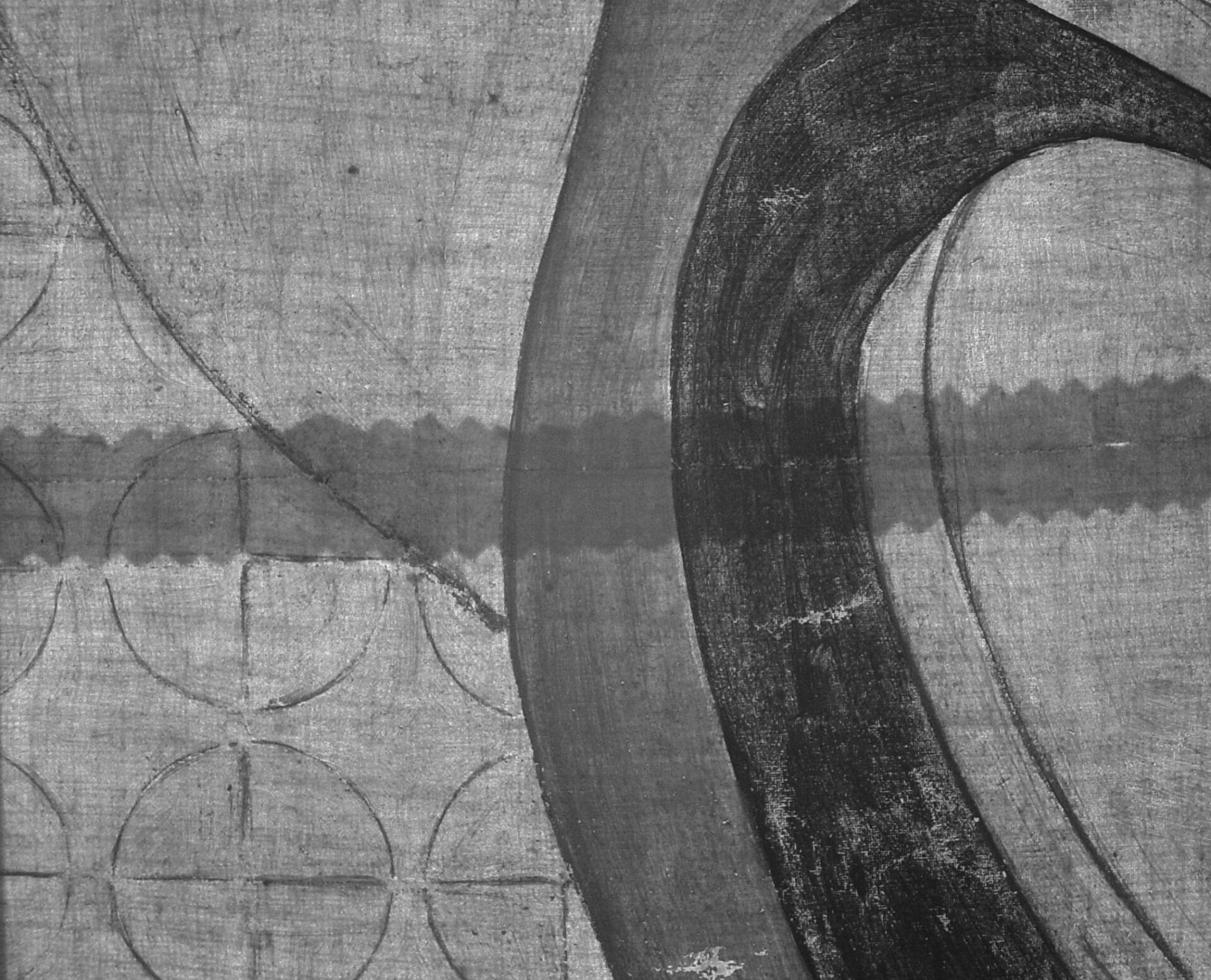


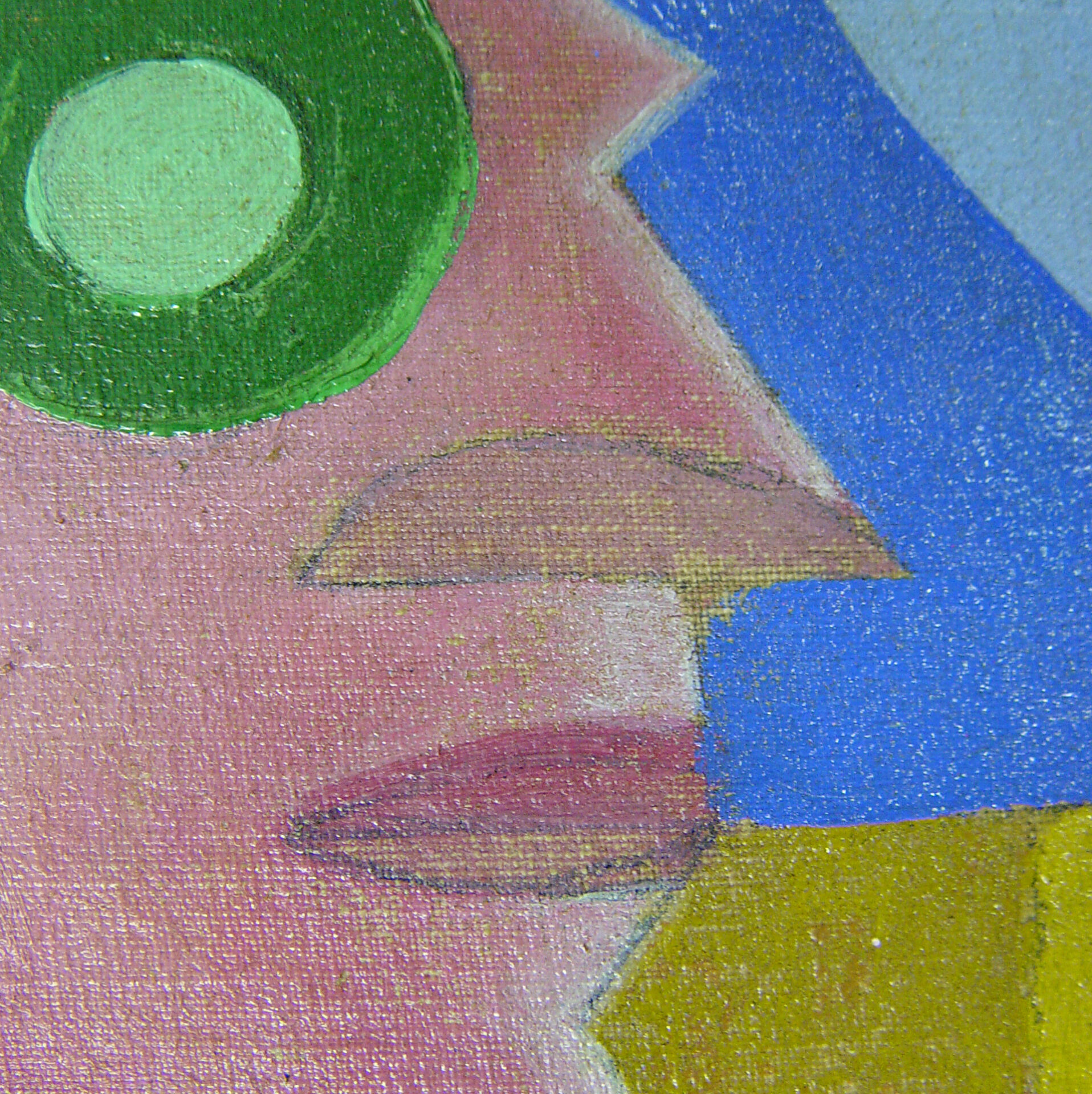
Presuming that such canvases – which were cheaper than industrially prepared ones – were also used due to budget constraints, the artist’s fidelity to this type of cloth reflects Depero’s peculiar approach to painting. Paying no heed to the canons of the academic tradition, he painted directly on the canvas, without an adequate layer of preparation. Ultimately affecting the conservation of the works, this must have had to do with the fact that the artist was trained neither in an academy nor in a school of applied arts. Depero was essentially self-taught; he was also eager to stand out, and a keen observer. The artist attended the Scuola Reale Elisabettina in Rovereto when the town was part of the Austro-Hungarian Empire; this high school promoted a liberal arts curriculum, in which drawing and geometry were the only subjects that remotely related to an artistic career – and the only ones in which Depero excelled. He ultimately dropped out in his fifth year, and failed the admission examination for the Academy of Fine Arts in Vienna.7
Some exceptions to Depero’s general rules of preparing paintings arise in works from this period that belong to other collections: for example, the famous Marinetti temporale patriottico. Ritratto psicologico (Marinetti Patriotic Storm: Psychological Portrait; oil on canvas; 86 5/8 x 63 in.; 220 x 160 cm; Private Collection) of 1924 has a white ground, visible along the borders of the canvas, as well as in places where color has faded.
Almost all the paintings included in the study appear to be varnished, often with the original coat. This condition is a testament to the fact that the works remained for a lengthy period of time in one collection, where restoration was wisely controlled and usually limited to specific areas of paint loss.8 Also worthy of note is the fact that lining was only found on three of the examined works, all of which were produced in 1917 and 1918. No cracks and fissures can be seen in the painting layers, if not in small areas, typically where the artist, as we shall see, retouched the painting years after having executed it.
The only work in which evident cracks in the paint layer are visible to the naked eye is Motociclista. In this case, they are predominantly horizontal, indicating, perhaps, that the canvas was at some point rolled. It is known that when Depero moved to New York in 1928, he took with him a number of painted canvases – Motociclista included – that he had first removed from their frames (a habitual practice to reduce transport costs). In other cases, cracks are made visible only with the aid of transillumination, as in the case of Città meccanizzata dalle ombre and Flora e fauna magica. Regardless of multiple or thick layers of paint, these thin cracks would not appear under normal circumstances.
Depero employed a painting technique which, judging from the use of support and the thickness of the paint layer, may, on the one hand, call to mind stage sets and decorative furnishings and, on the other, certain Renaissance works – such as the rare Nordic Tüchlein,9 Mantegna’s glue temperas, and even the ephemeral Renaissance set designs of which very few examples remain.
The primary risks posed by the conservation of these paintings stem from their brushwork, which is varied and, in thinner parts, exhibits localized chromatic variations; potential flaws in the adhesion of the paint to the canvas – such as flaking, loss of paint, and a propensity to abrasions; and the supports’ uneven absorption of the binding materials (i.e. drying oils and possible additives), which gives rise to inconsistencies, such as dryness, matte effects, or opaqueness, that reflect the loss of much of the oil necessary to maintain a transparent appearance. At least in these early years, Depero wittingly chose a technique characterized by simple brushwork and fast drying times that enabled him to expedite the execution of his works and control the uniformity of their surfaces, as well as their final overall look. In these pictures, there is usually a single layer of color that permeates the composition, save areas where there seem to have been successive retouches and modifications, with a rare and considered use of superimpositions and chiaroscuro to render volumes (an aspect that gradually gained weight as his painting evolved).
Surface alterations and pigments
The binding material in the works examined appears to be oil, but in at least one case, Diavoletti di caucciù a scatto (Little Rubber Devils) – where retouching has served the purpose of remedying local color loss – there are no signs of varnish; the surface is opaque and even seems to have been painted with tempera or, more probably, a thin oil. Though present on the surfaces of several paintings, in this work there is no yellowing, nor are there brownish lumps (figure 5), which can easily be eradicated through a light mechanical removal operation.10 A more in-depth study to determine whether these brown lumps can be linked with the original paint (possibly due to poor quality and rich in drying oils), the solvent (possibly drying oils with additives) or the varnish is currently underway. In this vein, an FTIR spectroscopy analysis of the bumps on Paese di tarantelle has revealed the presence of proteic material mixed with natural resin, as well as some particles of lead white and calcium carbonate, thus suggesting a problem caused by the varnish.
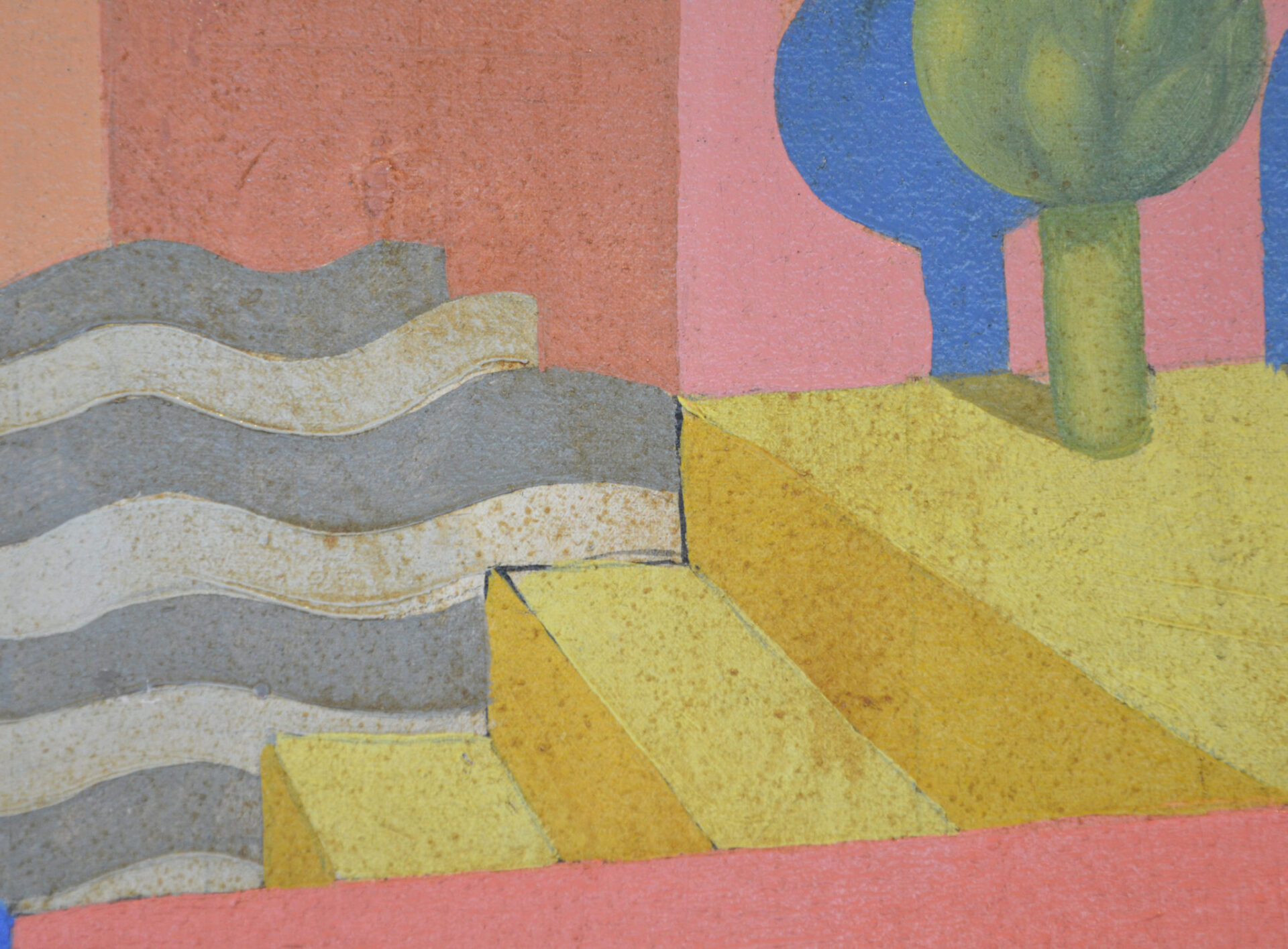
Exhibiting no signs of yellowing and only a few cracks and local abrasions, I miei balli plastici (My Plastic Dances) is a similar case of fruitful conservation. Though it was cut in size by a few centimeters and most likely varnished again as it was being relined, this canvas was not repainted by Depero11 (figure 6).
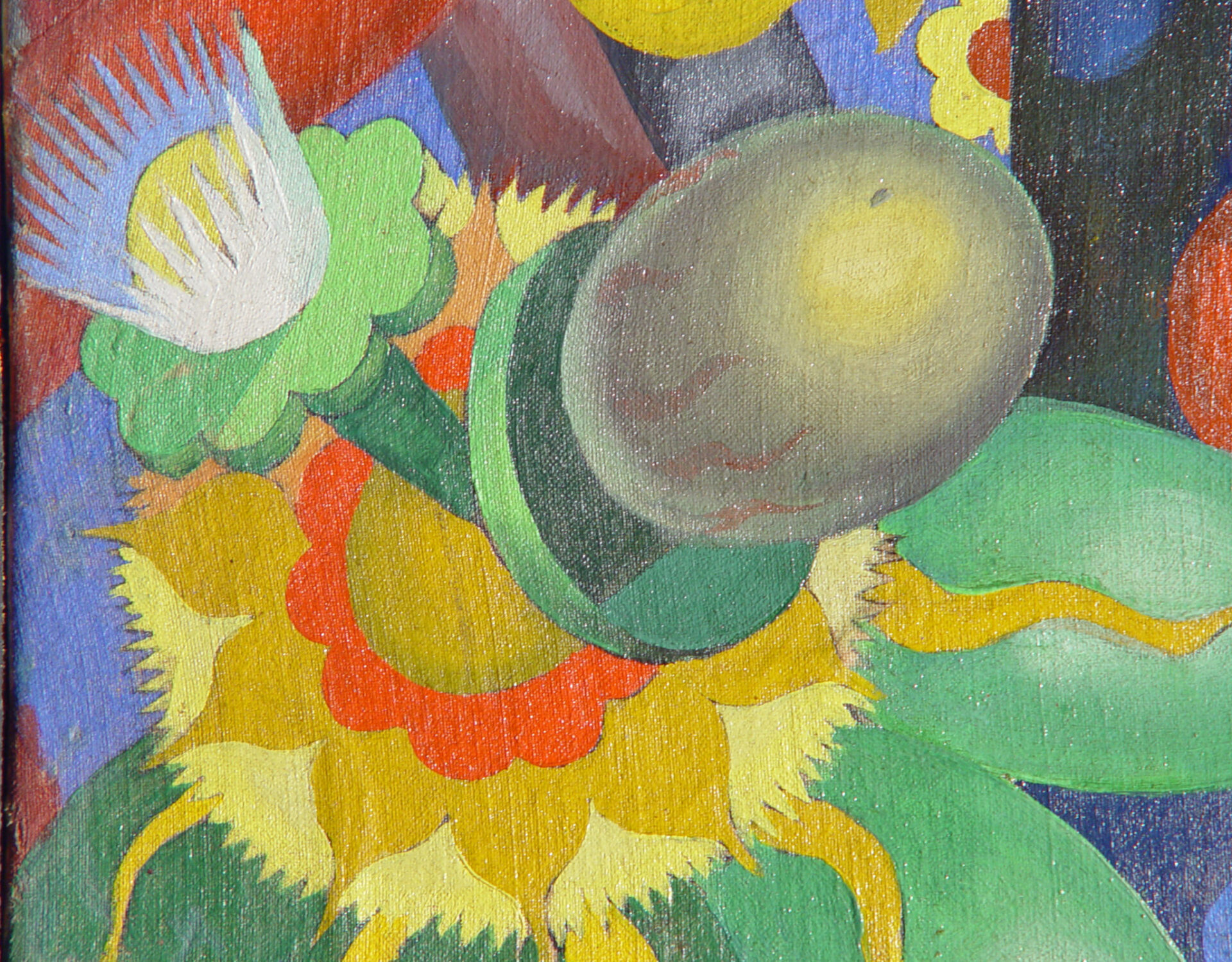
In the absence of documents, it is impossible to confidently ascertain the brands or types of colors used by Depero. Nonetheless, it is fair to posit that he used tubes of oil paints. Furthermore, vis-RS spectroscopy analyses carried out to date on points of different colors in each work have revealed the presence of numerous pigments.12 In particular, these studies have revealed Depero used the entire range of blues available to him, including ultramarine blue (artificial), cobalt blue, cerulean blue, and occasionally Prussian blue, which tends toward a green undertone.
Depero also had a marked preference for greens that are opaque to IR wavelengths (such as cinnabar green and Scheele’s copper arsenite green), as well as (usually hydrated) chromium oxide greens and greens obtained with cobalt blue pigments (though these pigments appear less frequently). For the violets, he typically employed cobalt phosphate or pigments with an organic dye base (like lakes). Among the reds and pinks, Depero used vermilion, cadmium red, and hues derived from crimson-type lake (which has a purplish tone), and a garance-based dye (with a deep red and even purple tone); these colors are also typically present in the watercolors.13 Regardless of medium, ferrous oxides (clays and ochres) appear infrequently.
Rarely does spectroscopy analysis make it possible to speculate whether Depero used a mixtures of different pigments – except for combinations with white and other peculiar cases. This state of affairs points to the artist’s preference for using ‘pure’ colors, meaning the colors supplied by the manufacturer, rather than working with mixtures on his palette as in the traditional method. The only sample we could take originated from a green area on the left border of Diavoletti di caucciù a scatto, and microscopic analyses revealed that this section comprised mixture of chromium green, zinc yellow (zinc chromate), lithopone white (a mix of barium sulfate and zinc sulfide), gypsum, and, peculiarly, particles of green earth (celadonite); results also revealed the presence of some red grains of vermillion, though no coat of varnish appeared to be present. Considering these findings, it is hard to say if this mixture of pigments was probably made by the painter himself in order to obtain a different tone of green, a hue that was ‘dirtier’ with respect to other areas.14 For whites, he mainly used the zinc oxide besides the traditional lead white.
In the examined paintings, it is often possible to detect sporadic lumps of color and brush hairs. Where chromatic alterations are concerned – for example, in some cases, certain shades appear discolored – pink is a notable shade. Indeed, in the 1917 Ritratto di Gilbert Clavel (Portrait of Gilbert Clavel) – held in the Mattioli Collection – it is possible to see a deeper shade of pink than is present elsewhere along the lower and left edges (in areas which must originally have been protected by the frame, in the stripes of the floor, and in the background with the square-and-circle motif). This pigment is a crimson-type red lake15 that is almost surely synthetic and has likely undergone a process of photo-degradation (figure 7). When it arises in other paintings, the hue appears to have suffered similar damage, unverifiable to the naked eye in the absence of protected comparative areas. The Ritratto di Gilbert Clavel is also important in terms of conservation. The work helps us understand the effects brought about when a painting is composed without a preparatory ground, and developed with thin layers of color: in areas of the background, passages of color – namely blue – demonstrate a lack of chromatic uniformity, resulting largely from the heterogeneity of Depero’s brushwork and the fact that, over time, the yellowish color of the preparation has come to the surface.
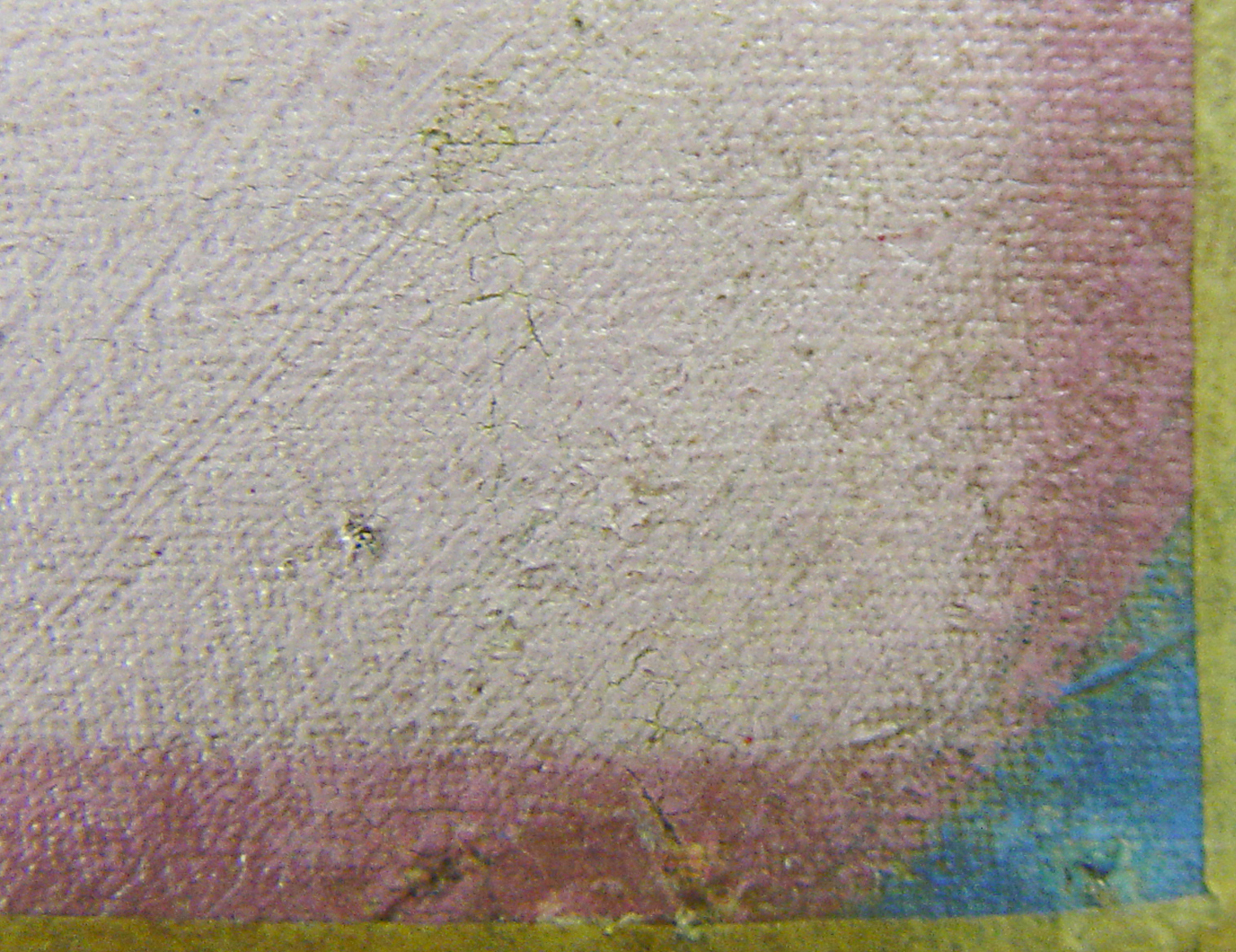
Underdrawing and variants
Depero’s simplistic and expeditious work method is confirmed not only by his paintings, but by numerous preparatory sketches on paper, as well as by the results of infrared analyses, which exhibit scrupulous underdrawing. Depero apparently deemed preliminary drawing on canvas to be essential for establishing the background surfaces of his pictures, which could then be painted in different colors, with few mistakes or secondary thoughts.
The distinguishing feature present in all these paintings is the quality of their lines, which are used to precisely delimit the various forms and elements of the composition. In works from 1918 onward, it is often possible to observe, through IR images, square grids which were likely designed to carefully control the underlying drawing in larger pictures. Depero generally transferred his drawings from paper to canvas by enlarging his images rather than using semi-transparent paper (translucent or oiled paper), and he adopted the same method when preparing the compositions of his tapestries. The artist seems to have followed this practice when creating his 1919–1920 Studio per Cavalcata fantastica (Study for Fantastical Ride), held in a private collection, where one finds a grid that has been vertically halved, creating rectangles, to increase the precision of the transferred details (figure 8).
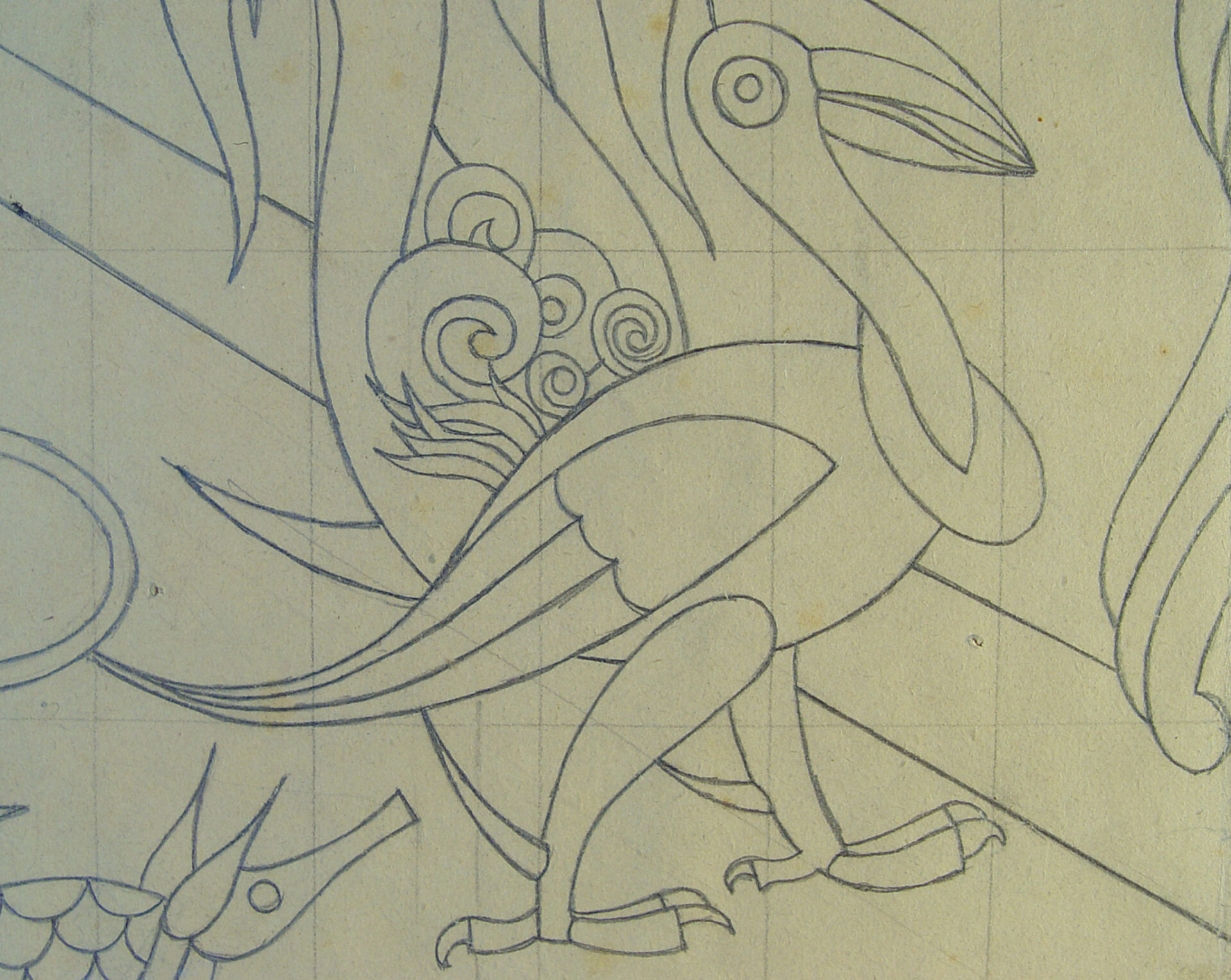
Involved here, in all likelihood, is a technique that Depero learned in school, one that proved especially effective for his subjects. The preparatory drawing was completed either in pencil or in black ink (probably India ink) with regular lines, executed not only with rulers and compasses, but also with freehand (to achieve numerous details and curvilinear forms). For instance, a reflectogram16 of the Ritratto di Gilbert Clavel in the Mattioli Collection shows extensive freehand drawing (figure 9), despite the rich geometry of the painting itself: the lines of the floor seem to have been drawn without a ruler, nor, as the graphic elaboration shows, are they parallel with each other (figure 10). The more approximate quality of the forms in this work – which itself is largely considered to be an experimental project – can be explained by the absence of a grid.17 In at least one case, for a work that evidently was to be easily produced in several copies, Depero prepared a perforated cartoon to transfer the image. There is evidence of this procedure in the poster for I balli plastici (Plastic Ballets; oil on canvas; 39 3/8 x 27 9/16 in.; 100 x 70 cm; MART – Museo d’Arte Moderna e Contemporanea di Trento e Rovereto; from now MART), in which small black dots are clearly visible around the words and figures.


An interesting photograph portraying the 1920 Flora e fauna magica on an easel in Depero’s studio as it is being executed, surrounded by several others works on the walls, has the potential to elucidate the process by which the artist painted his canvases.18 An accurate scrutiny of the extracted detail (figure 11) reveals the beginning of the coloration process: the underdrawing, which has been carefully executed, is only partly legible in this section of the photograph; however, it conveys that the painter did not start his picture using a single color tone, but proceeded to cover various areas of the composition (both in the foreground and in the background, with no apparent hierarchy) with different colors.
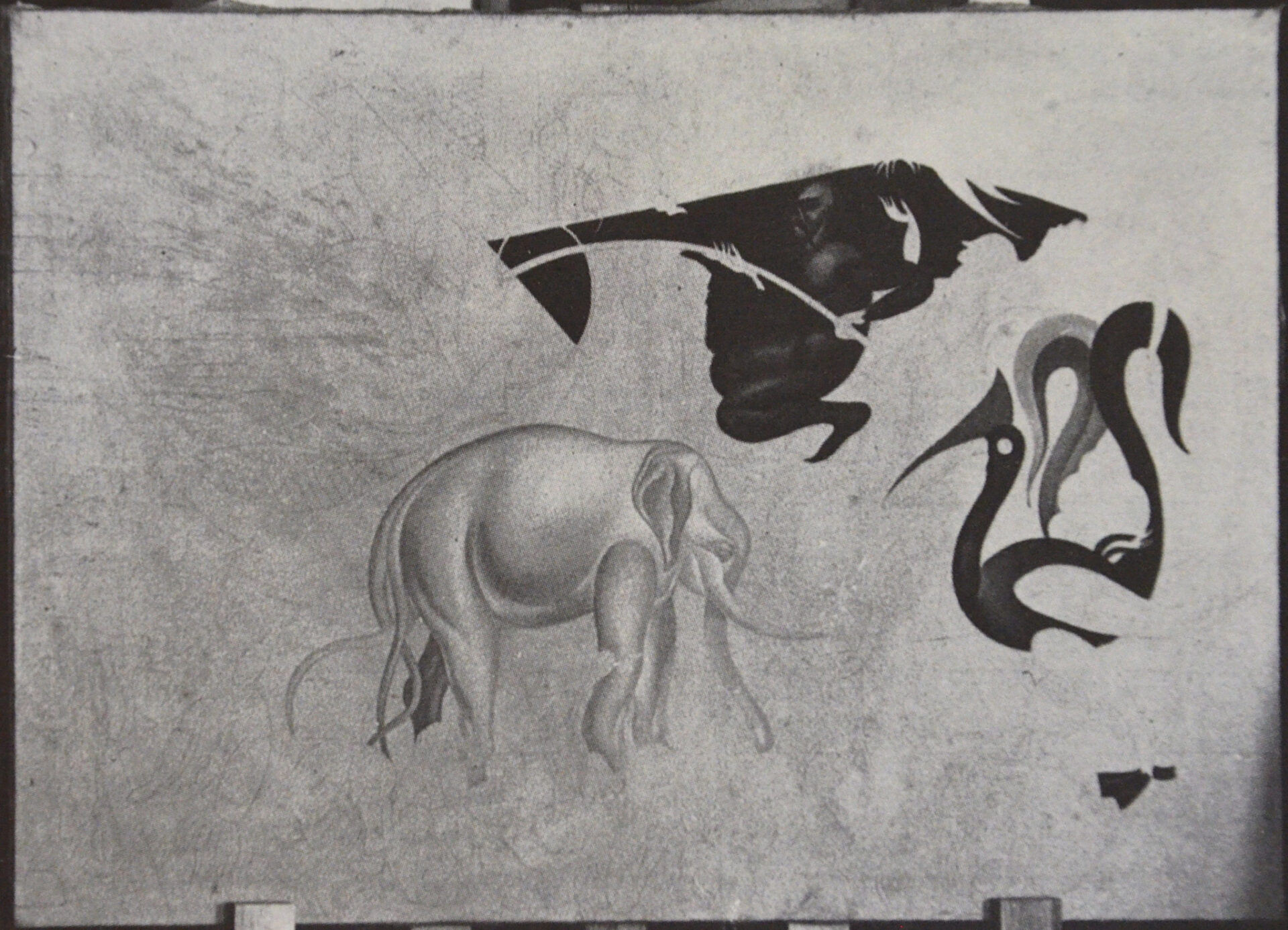
The 1918 I miei balli plastici demonstrates a similar process of painting. Apart from small changes – such as removing the cigar for the men in the line on the right and the curves in the legs of the small central ballerina – ideas seem to have emerged beneath the layer of paint which were drawn and then abandoned in the ground: under the green sea, waves were carefully drawn with equidistant curves, as well as under the large savage; this figure, however, must not have been planned. Two figures with zigzag outlines, (possibly a flash of lightning and a bird) seem to have been drawn over him (figure 12).
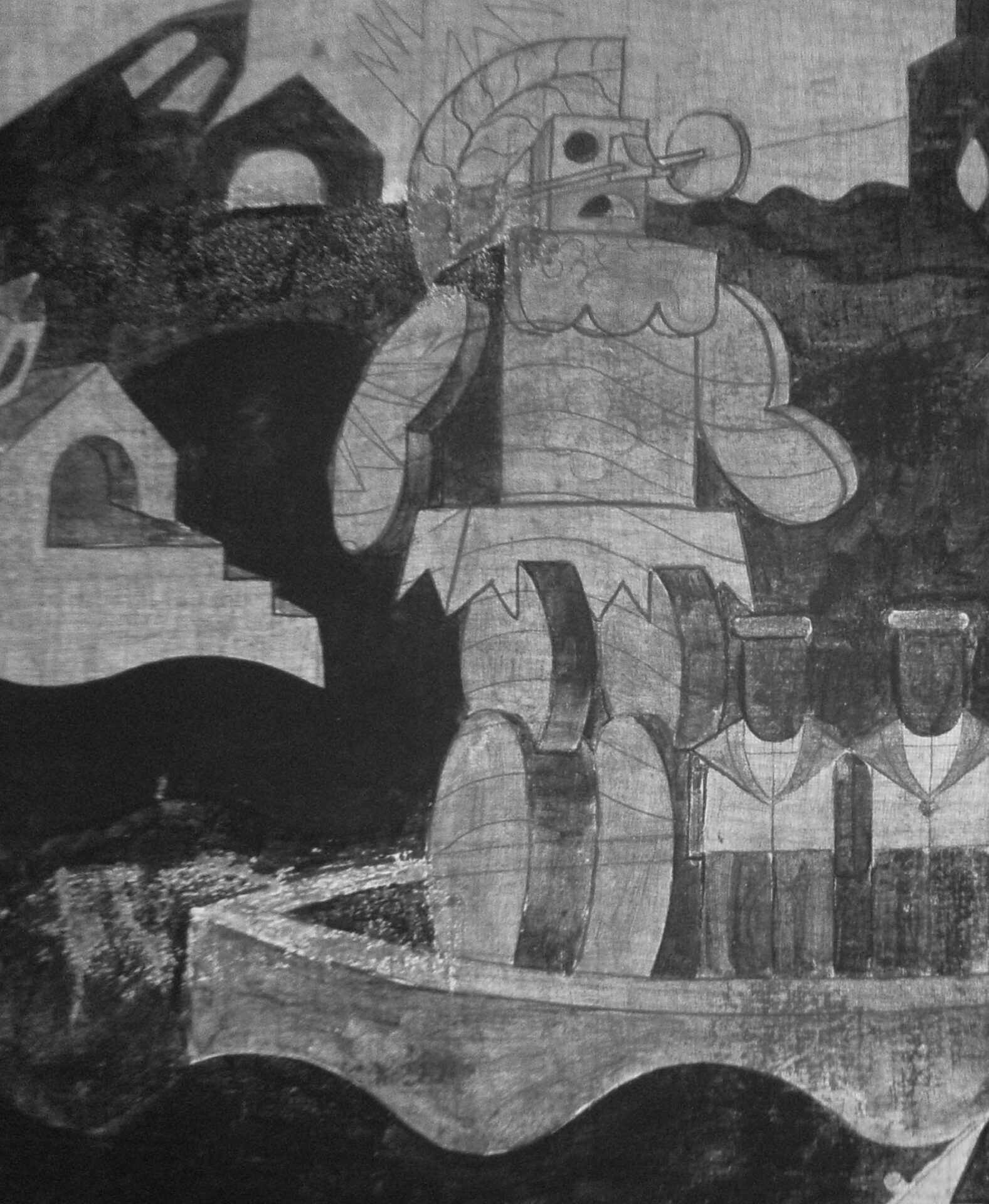
Studio per I miei balli plastici (Study for My Plastic Dances – a sheet dated May 12, 1918 which belonged to the composer and pianist Alfredo Casella – was the first version of this composition: in it, the savage is absent, and three rather than four sailors have been portrayed (figure 13).19 The format of this sheet, furthermore, is larger than that of the canvas. In fact, an archival photograph of the painting on display at MART, which shows that the format of the canvas is similar to that of the drawing, sheds light on the fact that the painting was cut at the bottom by 10 cm (3 15/16 in.; figure 14), thus eliminating following painted inscription: “I miei balli plastici rappresentati a Roma nel maggio 1918” (My Plastic Dances performed in Rome in May 1918). This loss notwithstanding, Depero’s original blue, italic signature in remains visible. It is hard to pinpoint the exact reason that this canvas was shortened; however, it is fair to posit that the picture was cropped for the purposes of conservation. In other respects, the sheet foreshadows the final version of the painting: for instance, the waves in the background have been drawn but not yet painted.
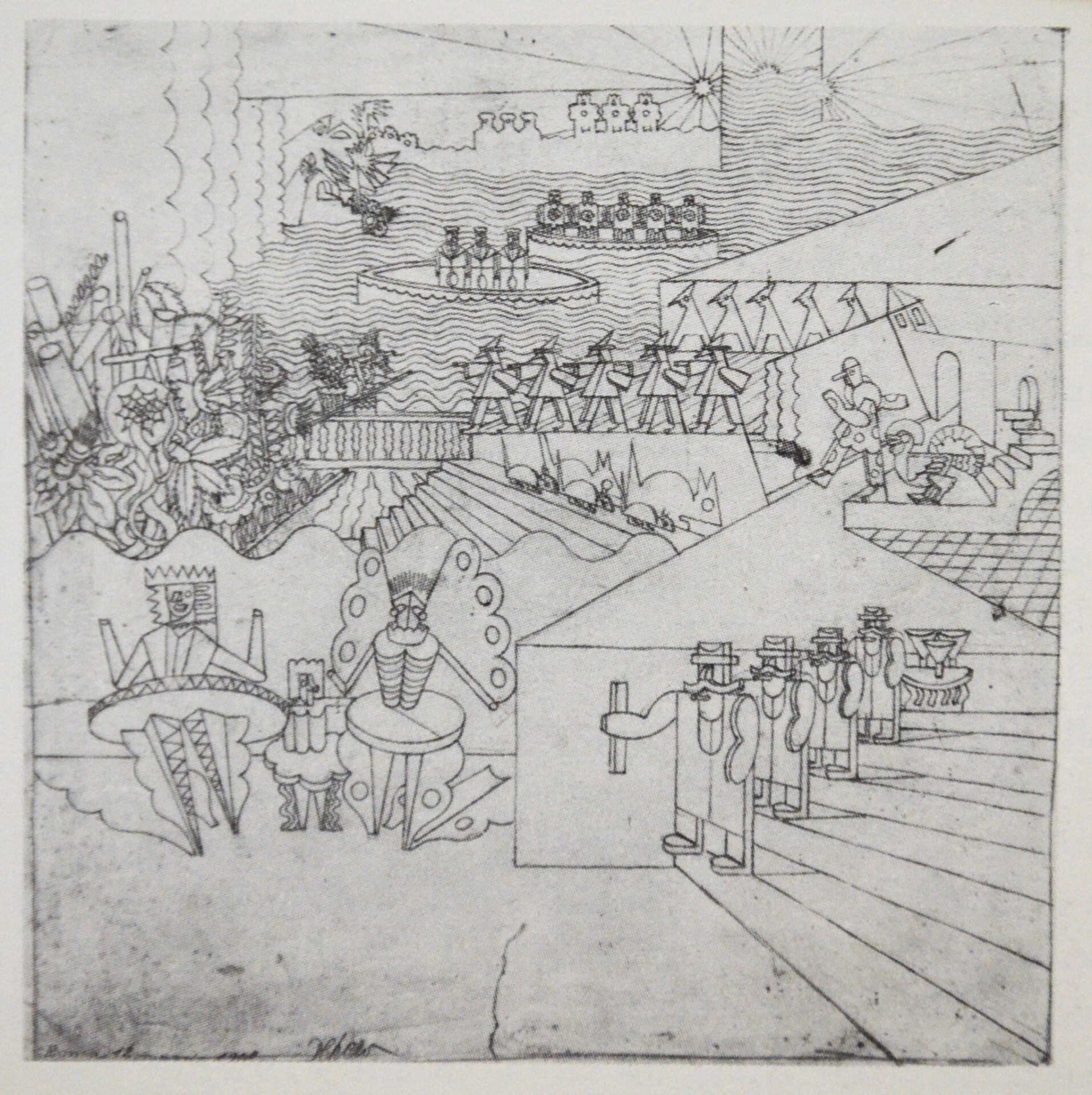

Beyond revealing the late repainting of certain hues, Paese di tarantelle evinces some modifications applied to the drawing, as well as to the first painted version. In particular, the clothes of the woman in the foreground and her doll were drastically simplified. Her folkloric costume was first drawn and then painted with copious lace and stylized pleats in the apron (figure 15). Yet, Depero ultimately decided to rework the painting by covering the lace on the breast with black, as well as various shades of blue with white. Judging by the appearance of the composition’s surface – which shows the characteristic yellow-brown marks caused by alterations of the binding agent or the varnish present in the oldest parts of the work – this dress must have been altered not long after the year it was initially executed.20
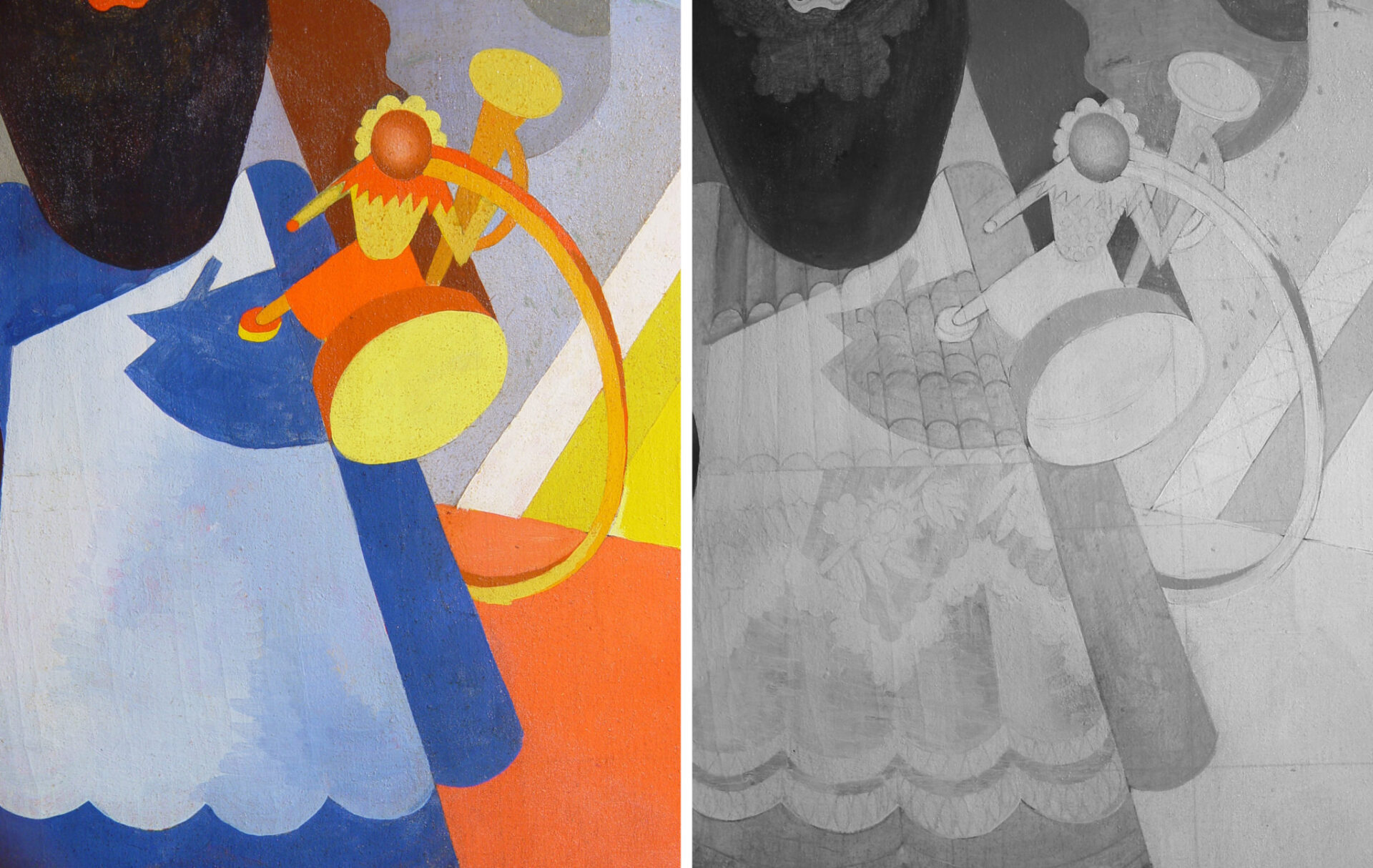
Old photographs of this painting, taken at different times throughout its conception, convey even starker differences between the forms present in the first and second versions of Paese di tarantelle (figure 16). Certain pictures21 – such as the aforementioned image of Emidio Filippini depicing Flora e fauna magica on Depero’s easel (figure 16, top) – show the first version of the costume, when it was rich in color and detail and, in all likelihood, was perceived to disturb the overarching effect and sense of the composition. In this iteration, even the woman’s shoes are decorated with a lobed opening, while the man wears boots and thick socks with stripes and zig-zags up to the knee. Contrastingly, in a later photograph (c. 1922–1923; figure 16, bottom) the painting appears to have been reduced on the bottom and on the right in an approach similar to I miei Balli plastici. Filippini’s earlier picture (figure 16, top) also reveals that the white stripe above the low yellow wall which, in the most recent version of the painting, runs diagonally behind the woman once manifested as a sequence of squares divided into triangles of alternating colors, which can be clearly and better appreciated through reflectography.22 This form further evidences Depero’s driving need to simplify; this tendency is also buconveyed in various IR details: some dancers in the background initially had details drawn into their faces, costumes, and hairstyles, which were later removed, together with the red cart with wave-like decorations. The later photograph (figure 16, bottom)23 demonstrates that Depero applied extensive modifications not only to his woman figure, but also to the floor underlying the two men sitting at the round table and in the background to their left. In contrast to the final version of the painting, this ground was not divided using a deep pink form; it was barely toned down in shade, and not uniform in the red.
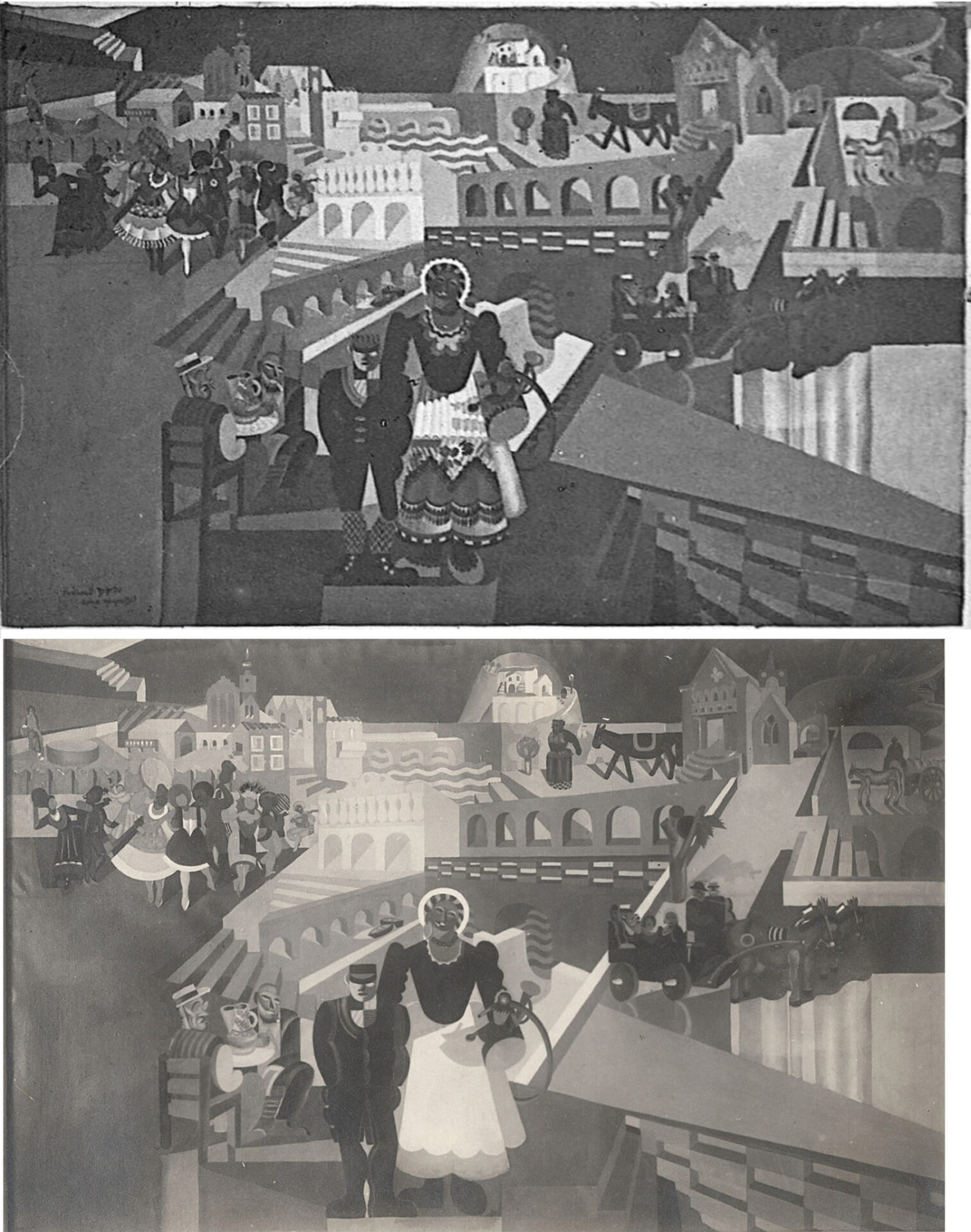
This photograph also shows that the present-day painting has been cropped by a few centimeters on the left and on the lower edges, thereby eliminating the step on which the foreground figures stood. In 1920, the painting was not yet modified. However, as is visible in a photograph of the Depero Room at the Rovereto exhibition of 1922 (MART. Archivio del ‘900, Fondo Depero; figure 17), it was revised by 1922. Naturally, it also appears to have been in its fully modified state when it was displayed on the large wall of Salone Depero at the Prima Internazionale d’Arte Decorativa of Monza of 1923.
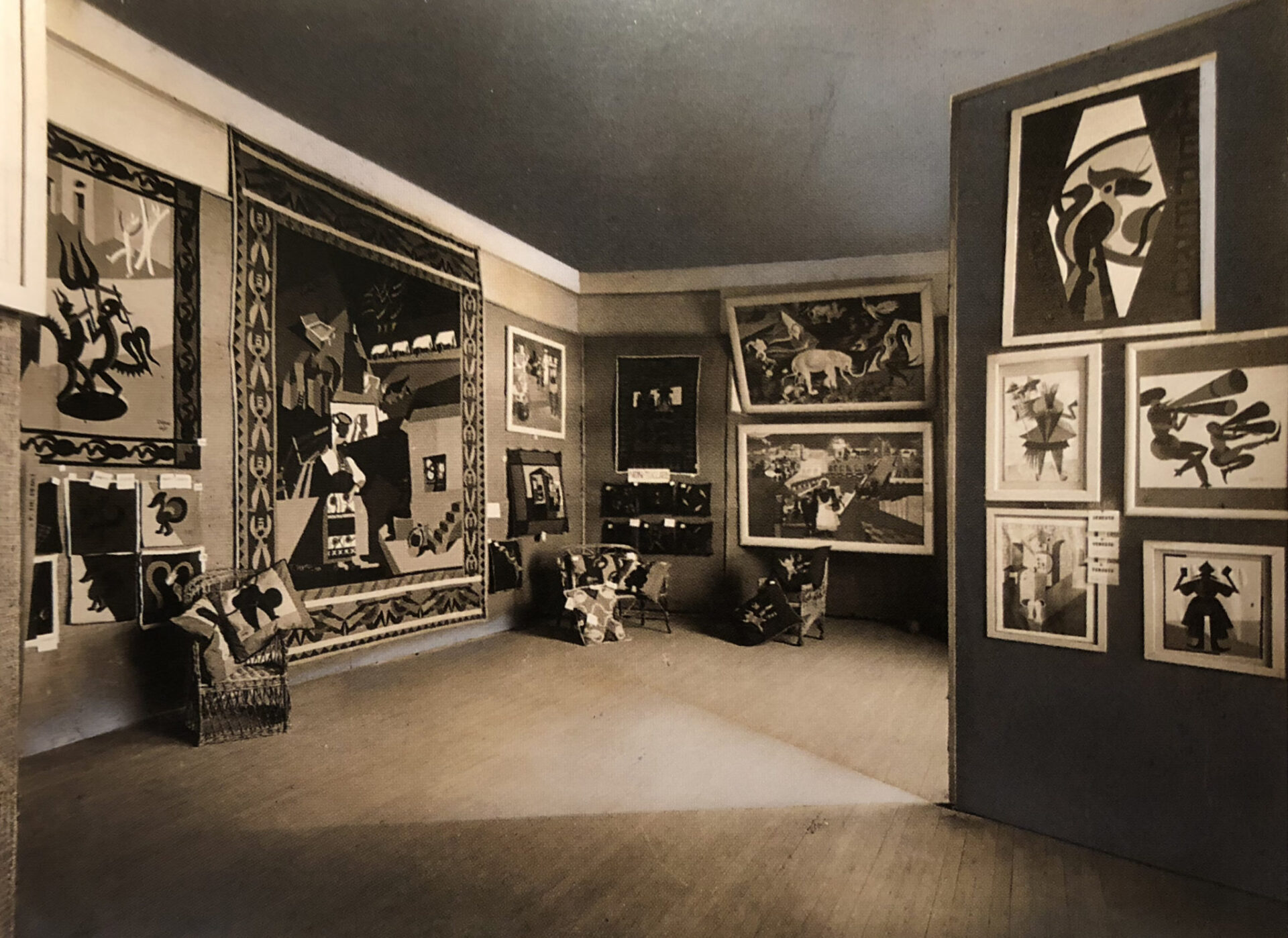
The IR images of the Paese di tarantelle also show that the painting support was reused: as revealed through a combination of various analytical techniques (i.e. starting from the evidence of oil absorption on the back of the structure), the canvas originally featured (under its current layer of paint and color) another subject – that, though partially completed in oil, was largely left in the graphic stage (figure 18, left).24 The reconstruction of this figure shows the underlying lines, marked in red, that have no relation to the subject visible today25 (figure 18, right).
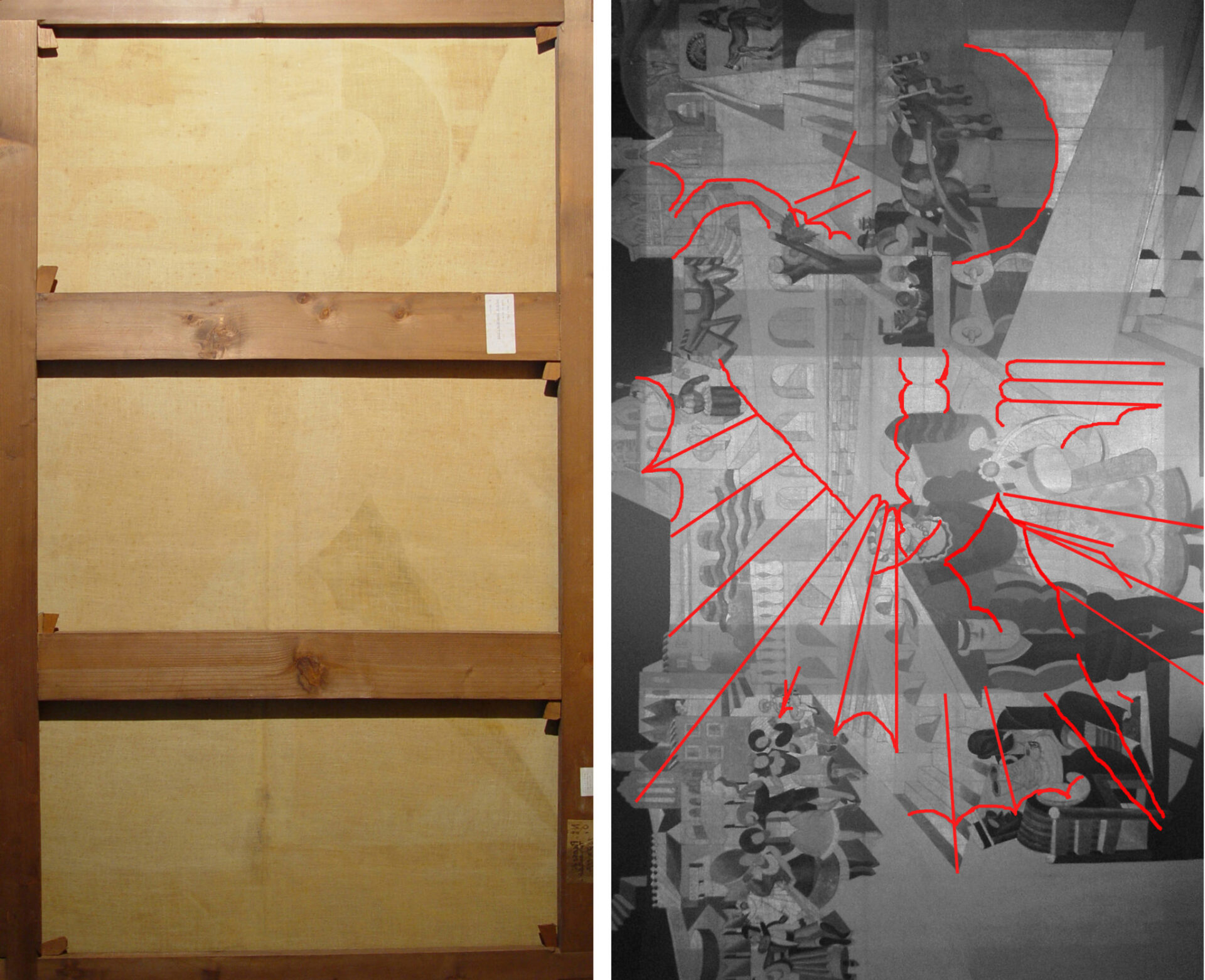
The initial picture features a large figure akin to those of the plastic theater and possibly comparable to the 1917 Rotazione di ballerina e pappagalli (Rotation of Dancer and Parrots; 35 1/4 x 41 1/8 in.; 89.5 x 104.5 cm), belonging to MART collections.26 With regard to this painting and the reuse of its supports, it should be noted that on the back of the canvas there is a careful preliminary drawing, ready to be colored, depicting the Prospettiva sotterranea (Underground Perspective). This subject can be associated with the illustrations for the 1917 book titled Un istituto per suicidi (Suicides’ Institute) by Gilbert Clavel, which is further linked to a drawing on paper, as well as a painted version in a different format and with variants, more horizontally extended, known as Clavel nella funicolare (Clavel in the Funicular) of 1918.27 The reuse of subjects is a leitmotiv of sorts in Depero’s oeuvre. The artist developed his ideas through various modes of visual expression and creative techniques, including graphic design, collage, painting, tapestry, advertising, and, later, inlay and marquetry; he made use of detailed drawings that were functional in terms of the so-called applied arts and often included indications of the colors to be used in the various background areas, though these are impossible to verify28 in the underdrawings of the paintings.
Infrared reflectography analysis of Io e mia moglie (My Wife and I) reveals a couple of interesting findings that place this work in close relation to two well-known drawings.29 Of these images, the square one represents the most advanced version, though the analyses have not revealed the presence of a grid. Nonetheless, in both it is possible to make out floors composed of square tiles that have been rendered through linear perspective. This design can also be read in the TIR images (figure 19), and the sole memory of it that remains in the painting is the alienating reflection in the mirror behind the jug. Depero must have suddenly changed his mind while painting Io e mia moglie, for neither the floors nor the shadow of the balustrade – which, in the drawings, appears at the bottom right, in the area where the signature (identified in IR, but neither painted in nor eliminated from the work) now appears – had been rendered.
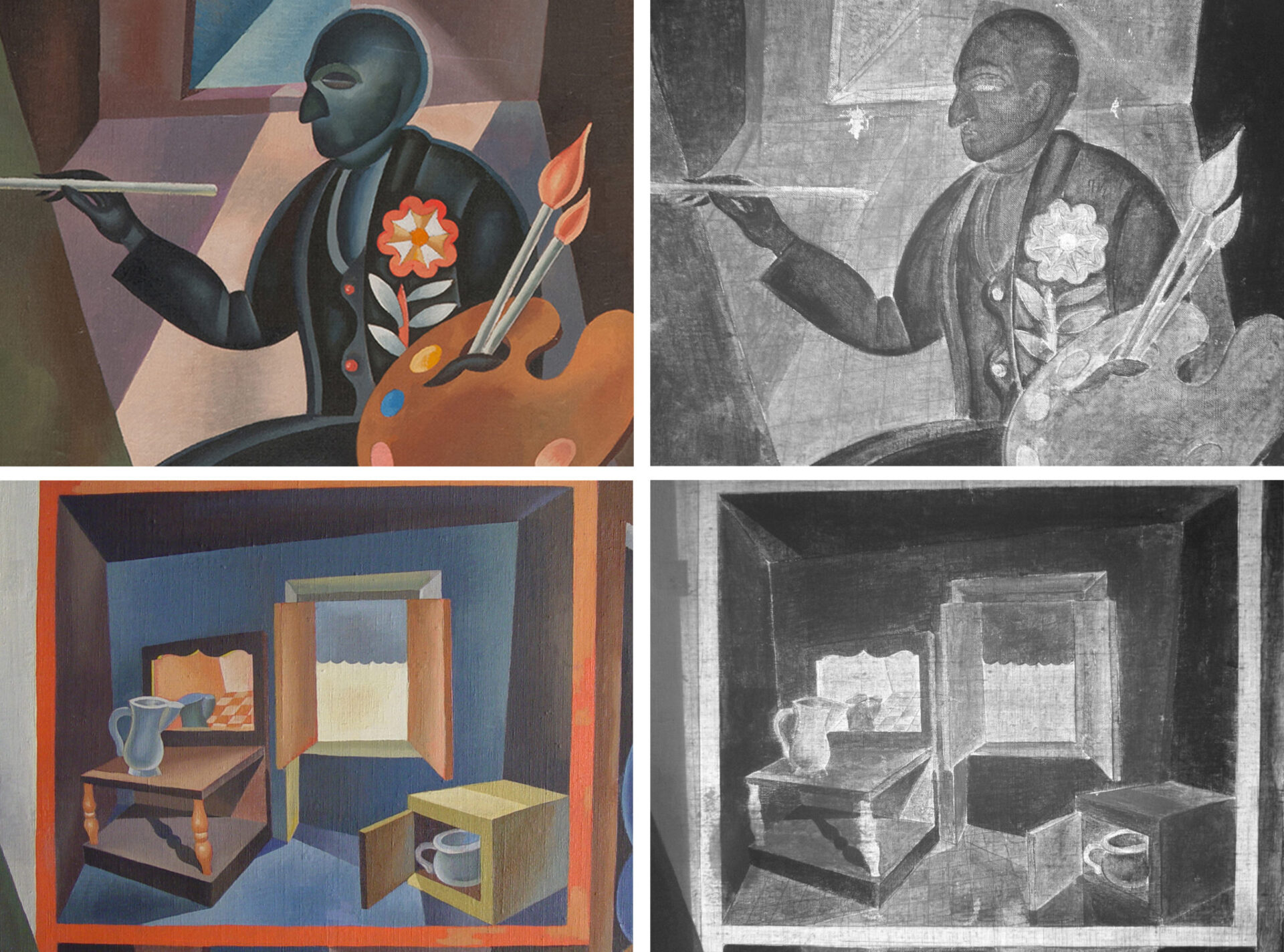
At an iconographical level, perhaps the most significant modification in this work is the painter’s head (figure 20), which in the first version (as in the preparatory drawings) was more realistic and bore an ear and mouth, the outline of hair, a narrow almond-shaped eye like the woman’s, and a more carefully depicted nose. The divergence of this portrait from the one in the final version documents a process of sudden pictorial rethinking, carried out by Depero while the work was under way. Depero clearly wanted to turn his self-portrait into a sort of deaf and dumb mask, distinguished and dignified, an indomitable head whose sole prerogative, as painter, is the eye reduced to a crack, just as his only tools are his brushes and colors.
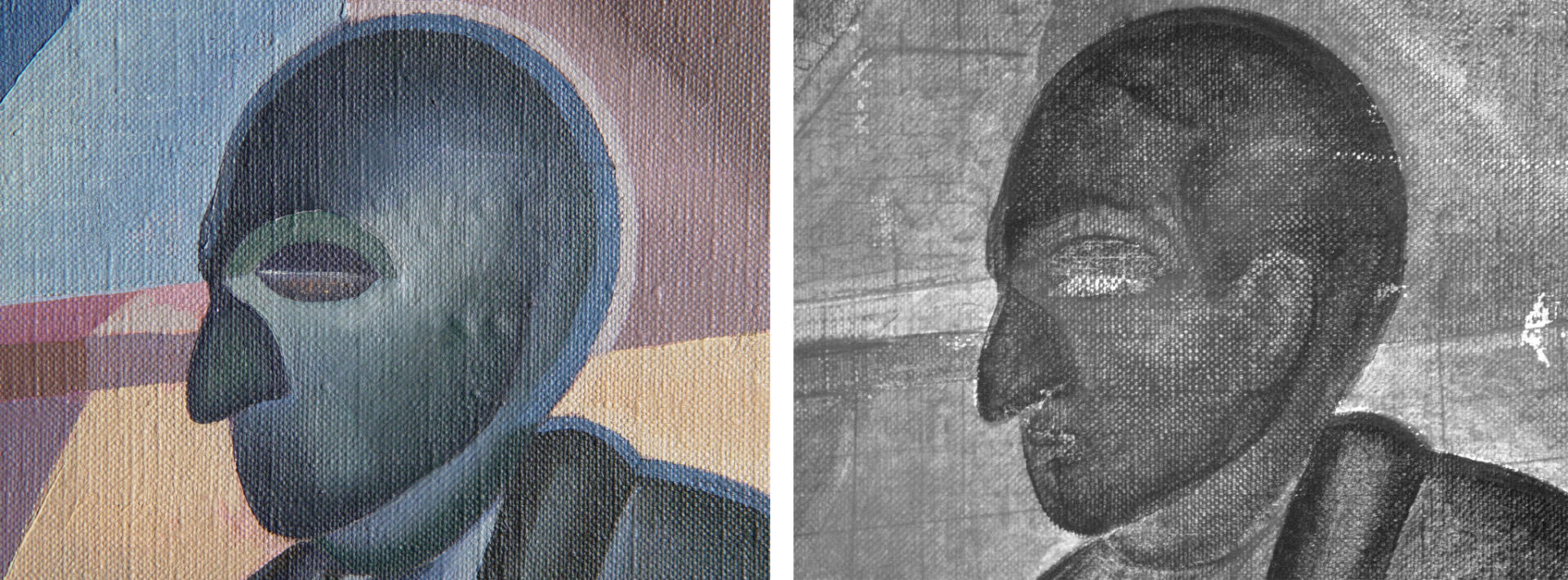
Another drawing (Studio per Io e mia moglie [Study for My Wife and I]; figure 21; charcoal pencil on paper, 14 x 12 3/16 in.; 35.5 x 31 cm) held in a private collection and completed possibly prior to the others mentioned seems to offer an interesting later reflection on this theme, showing an undivided house with a man in profile at the window, as well as the painter himself standing in front of an empty canvas holding a brush that manifests almost as flowing continuation of his (left) hand.
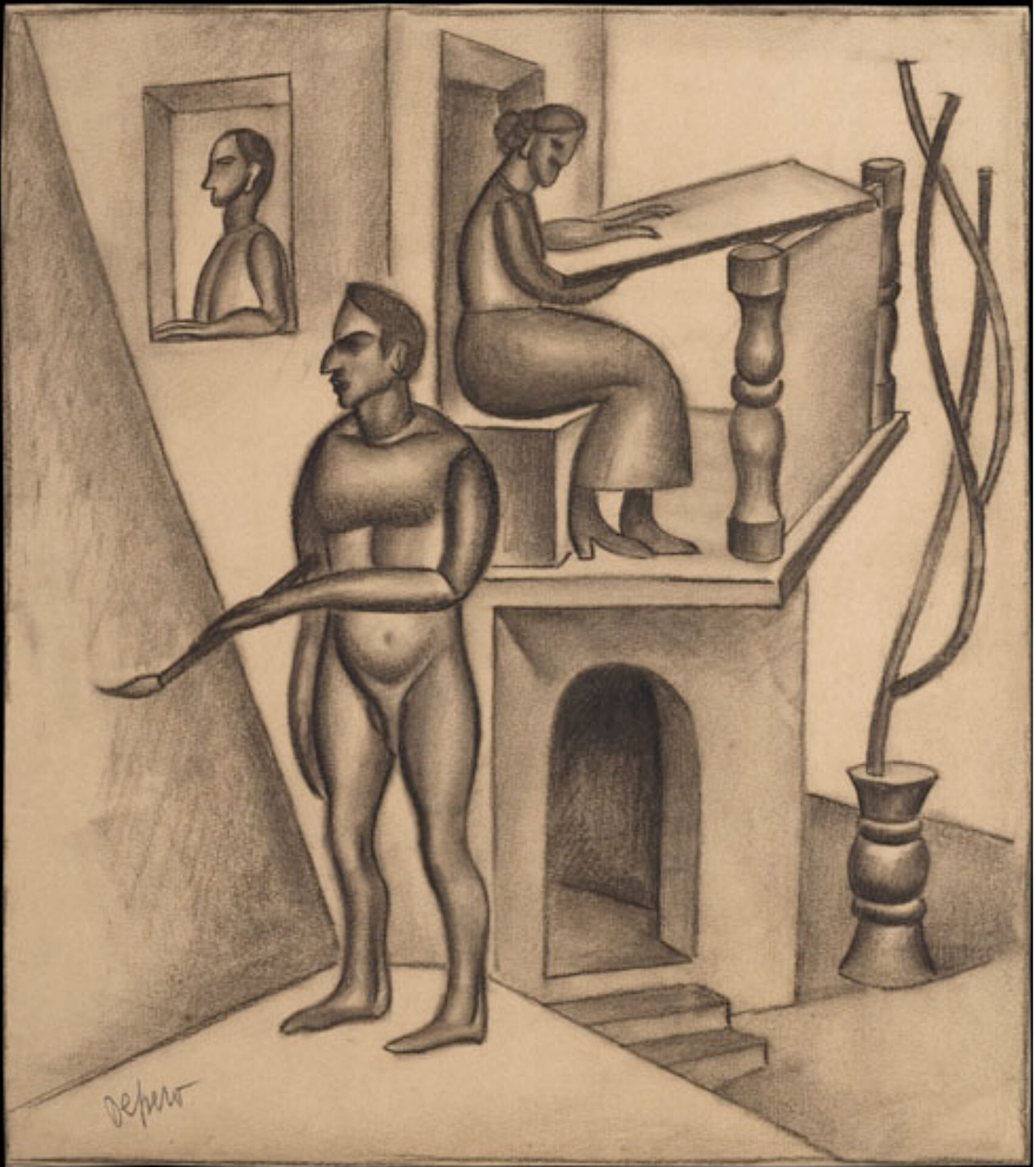
Among the outcomes of the diagnostic studies carried out, the findings obtained for the Motociclista warrant special mention. IR analysis brought to light an inscription reading “MOTOCICLI BIANCHI” (white motorbikes) in which the first word has been compressed to match the length as the second (figure 22). This finding calls into question the dating of this painting. Though usually associated with the years 1923–1925 in the photographic plate at the MART30 – Depero’s picture should probably be situated in 1927, the year in which the artist attempted to collaborate with the Bianchi company on their publicity campaign.31 The erasure of the aforementioned inscription likely reflects the firm’s refusal of Depero’s services. Motociclista appears as number seven on the list of works Depero took to New York in 1928. It is likely that he covered the writing on the painting prior to this date, thus making it possible to be offered on the American market as an autonomous work of art. The colors in areas of the painting that are disconnected from the covering of his inscription do not seem to have been rebalanced.
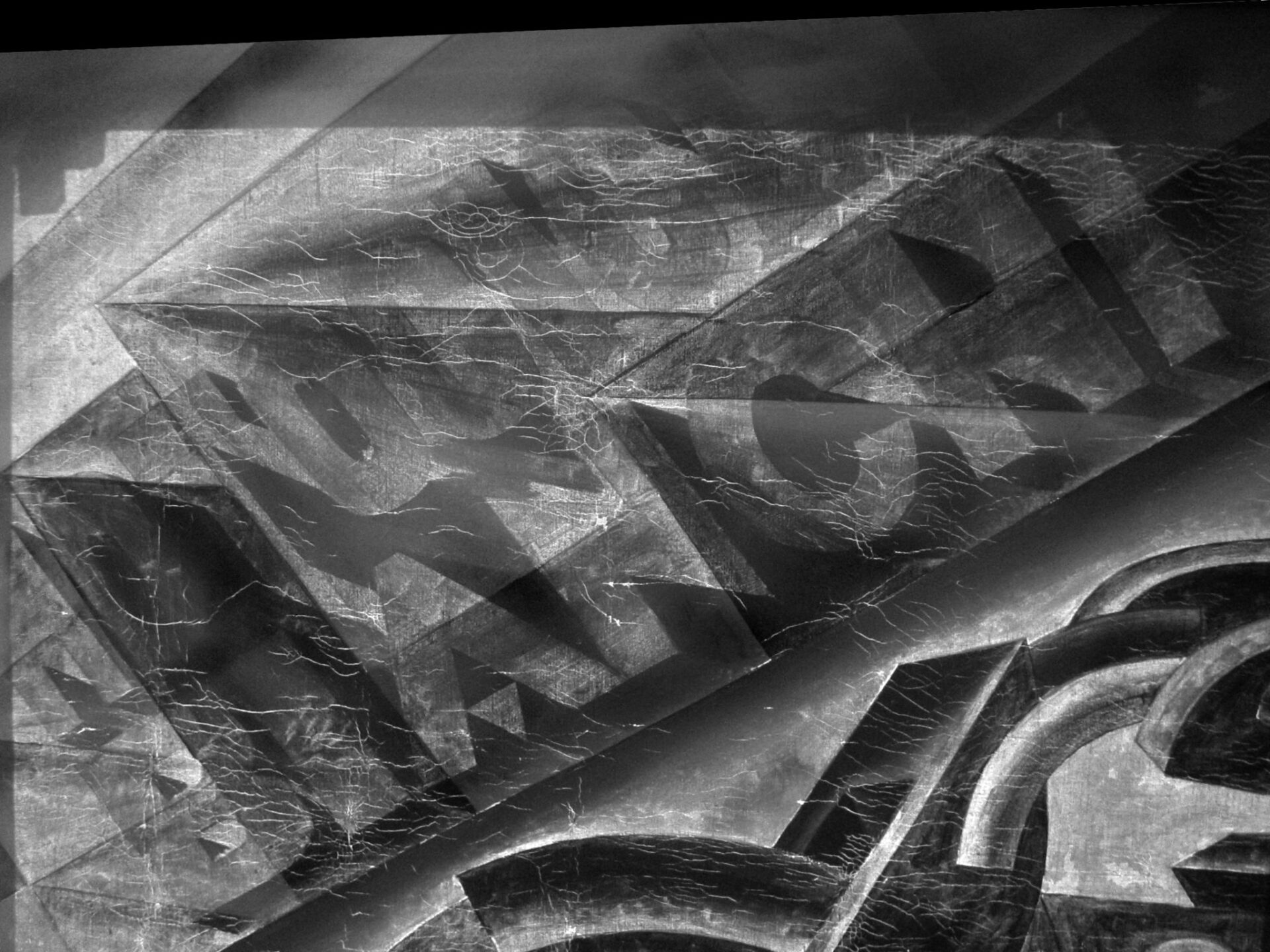
Depero restores himself
It is well-known that, in the later years of his life, Depero not only re-appropriated some of the themes explored in his oeuvre from the 1910s and 1920s, but also revisited some of his earlier works, restoring them to a greater or lesser degree.32 Scientific analysis has helped us understand the extent to which the artist reworked these pictures; they have also helped elucidate whether his interventions solely addressed problems of conservation (i.e. losses of color and chromatic alterations), or if they were a pretext for a sort of modernization, a revision in the light of a new sensibility to and experience of color.
Depero used the pretext of restoration to carry out interventions that were more extensive than required. He did so largely for economic reasons; however, it is fair to posit that he also aimed to adapt his works to contemporary taste. Painted in the autumn of 1919 and reworked in the early 1940s (possibly 1944) before being sold to Gianni Mattioli, Io e mia moglie is a particularly relevant case. It is common knowledge that, by 1944, Mattioli had already agreed to acquire this painting for 10,000 lire, with “retouches and partial revisions” included. It is thus rather unsurprising to find that, in a letter to the buyer from February 13, 1950, Depero wrote that he had repainted certain parts of this picture.33 When the collector received his restored paintings (he acquired others beyond the one examined here), he sent the artist a letter on June 18, 1944, in which he expressed his feelings for the work under discussion:
It has been a great joy to lay eyes again on all these works of yours, which you know I like enormously. The retouching of Io e mia moglie and the Selvaggetti is also perfect. The fresh, bright colors with which you have managed to rejuvenate them, like a real ‘magician,’ your technique and your extremely personal fantasy have created two works that thrill me today the way they did so many years ago, the first time I saw them. I am happy to be the fortunate owner of all the drawings and paintings which you have sent me.34
What clearly emerges from this letter is the transparent relationship between these two men: Mattioli was both aware and greatly appreciative of Depero’s alterations which, as the analyses show, went beyond the requirements of conservation (such as retouches associated with the presence of gaps).35 The infrared investigations show one or two places where color has flaked off. These areas are relatively small in size and are largely in the upper right zone of the zone of the paint, in the birds and branches, above the wife’s hair, on her forehead, and on the canvas on which she is working. Paint also appears to have been lost in the background, near the man. The canvas seems to have suffered some damage too, judging from the square inserts placed between it and the frame. Rather than locally retouching the damaged areas, the painter opted to redo the background in its entirety, so as to guarantee its chromatic uniformity.36 The various repainted areas and alterations of shade – including the insertion of light-colored patches not formerly present in the work – are summarily described in figure 23. Here, the findings of the analysis at hand are also compared with the old photograph. With regard to this historic print, the removal of the original signature (probably written in white), “Depero Rovereto 1919 (autumn)” (in block capital letters except for the season in brackets, which appears in cursive script), covered with a light shading that renders the ground less flat, should be noted. The new signature is located at bottom right, in cursive script, with the characteristic cut/barred “p.”
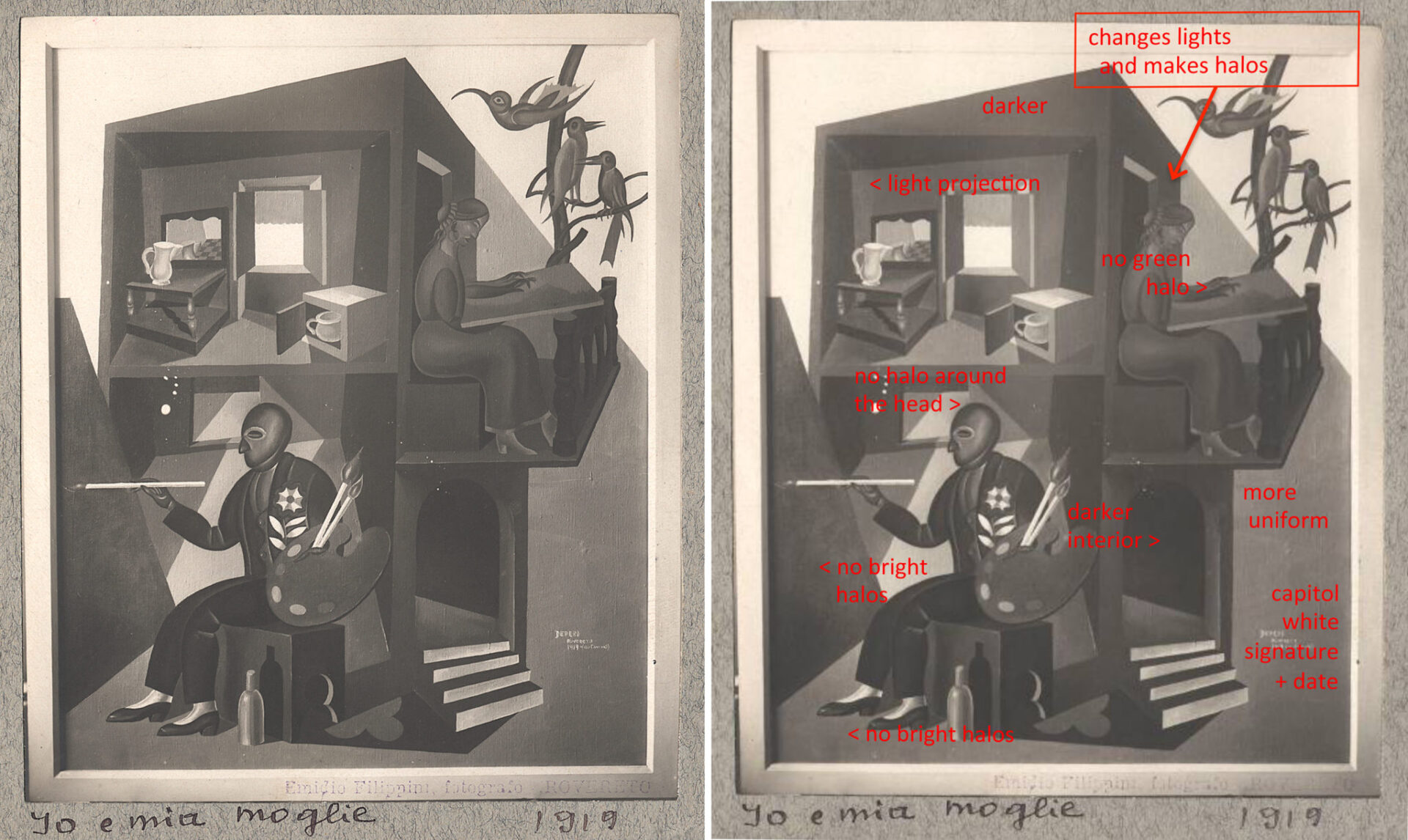
With regard to the elaboration of this painting, it should be observed that Depero worked with great accuracy, paying special attention to the colored shadings, the tones, and the imitation in this intervention; he probably considered the work to be a cornerstone in his artistic activity. The chromatic shadings, in particular, show the painter’s renewed sensibility for the plastic values of paint. It is likely that the retouching of some of the colors in the damaged areas of I miei balli plastici, such as the greens, was not carried out by Depero, and the alteration is not significant enough to be deemed a revision; however, as indicated earlier, in Paese di tarantelle, the repainting of certain shades of color – especially the reds, pinks, and blues – is believed to be Depero’s own work. In I selvaggi rossi e neri, it is possible to detect the touching-up of many tints (almost all of them), though certain changes of hue remain to the original colors that appeared on the cover of the magazine Il Mondo (V, 17) on April 27, 1919: the naked eye can make out the original chromatic layer on the edges of the background areas, with brighter reds and pinks, as well as the newer brushwork, which is denser, with the edges in relief, and more precise in the parallel traces. The signature (with the cut “p”) in cursive on top of the paint is definitely from a later date. Reflectograms do not show evidence of conservation problems; the interventions can thus be best explained in terms of taste and timeliness. While the Diavoletti di caucciù a scatto (acquired by Mattioli in 1931)37 evinces no repainting and is in a remarkably good condition, the Città meccanizzata dalle ombre has been retouched in two background areas (the pink bench shaped like an arch and the interstices of the baluster: not significant interventions). Moreover, a crack emerges in transillumination. Unlike the former work, the contemporary Flora e fauna magica includes a grid, and subsequent corrections of various color shades have erased the original signature (“DEPERO 1920”) which appears in IR images (figure 24), and was documented in an old photograph.

In this photo, the canvas – which is to have been partially repainted in the aforementioned letter of February 13, 195038– exhibits the beginnings of a blue form in the shape of a barbed fish (represented through a colored shadow) on the left and, above all, shading (akin to that in Io e mia moglie) in various areas of the background, including the section of blue on the right. Spectroscopic and multispectral analyses show that the original color in the areas between the proboscis and the bird and behind the bird’s head was light blue, and that the area on the right, towards the edge of the canvas, was retouched by Depero with quite different pigments: though he originally used cobalt blue, he retouched the area with a Prussian blue lightened with white.39 Overall, the appearance of the painting does not seem to have changed considerably compared to that of the original, and the restoration can barely be justified on the basis of slight damage.
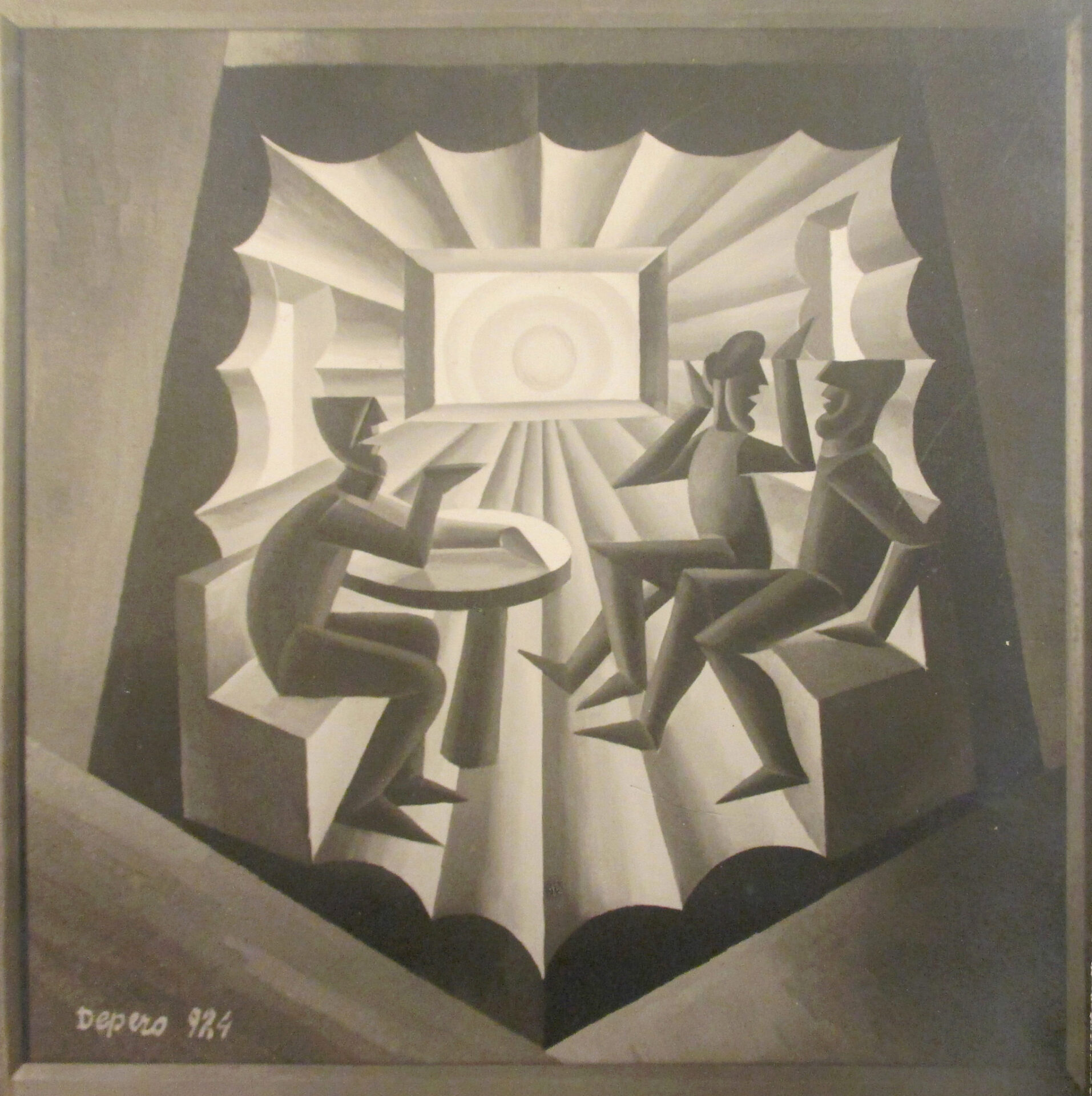
Where the 1924 Spazialità lunari, o Convegno in uno smeraldo (Lunar Space, or Meeting within an Emerald) is concerned, there is a valuable photograph that illustrates the first version of the painting. The outer edge of this original composition is noticeably different from that of the existing work (figure 25). Close observation of the boundaries of each form (figure 26) shows that the central area was originally green (from pale to mid green): the figures were dark green; there are dark blue traces beneath the present light blue on the edges; and the pentagon delimiting the area was possibly black. Through reflectography, the signature of the first version emerges in the lower left corner. The date of the intervention – which was likely dictated by the desire to alter the tone of the image, rather than reasons linked to conservation – is unclear, even while taking into account the fact that in the restorations of the 1940s Depero was very careful not to impose his new style – consisting at that time of serried lines of color with constant variations in shade. Probably in an attempt to be attentive to the wishes of collectors (at least in Mattioli’s case), the artist tended to operate with rather flat areas of color, akin to those found in his works of the 1910s and 1920s, with just a tendency to shading, which was useful to make the surface vibrate.

Depero’s lack of precision as he set about covering background areas with their original colors (which, in my view, was deliberate) is apparent in several of his other works, such as the 1917 Meccanica di ballerini (Mechanics of Dancers) currently at the MART (oil on canvas, 29 1/2 x 28 1/16 in.; 75 x 71.3 cm), in which the large dark green area behind the figures is overlaid on an initially lighter hue.40
At this point, a brief consideration of Depero’s ‘restorations’ in the realm of sculpture may also be in order: of the three works examined – apart from the Selvaggetto (Little Wild Thing), which retains its original coloring – both the Testa (Head) and the Cavaliere piumato (Plumed Knight; 38 3/16 x 36 5/8 x 17 3/4 in.; 97 x 93 x 45 cm; Private Collection, Switzerland), produced in 1923, were repainted, probably by Depero himself, before being sold to Mattioli. Indeed, phthalocyanine has been identified to exist, unambiguously, among the green pigments in both works,41 along with titanium white: this latter pigment was available in shops from the 1920s onwards, but phthalocyanines (synthesized in the late 1920s) were not available until 1935, and even then would not become widespread artists’ materials for some time. Without specific samples, it is impossible to describe the original palette of Cavaliere, now painted with ultramarine blue. This task proves simpler when confronting Testa: the green in the present-day composition must be similar to the hue originally applied by Depero, even if slightly less bright. This condition is revealed by some areas of older color beneath the base (which manifest as a Veronese green or cinnabar green); a green of the same shade is also found in gaps beneath the black, suggesting that the head could have been monochrome, or else with fewer black parts.42
Conclusion [2013]
Undertaken on works of absolutely certain and uniform provenance (to reiterate, they were all acquired by Gianni Mattioli for his famous Milan collection, some directly from the artist in the 1940s), this study has helped us to gain a better understanding of Depero’s pictorial technique43 and enabled us to fully appraise the nature and extent of the restoration he carried out. As the analyses show, Depero developed a fairly simple painting technique, probably owing to various motives that were both aesthetic – as he himself indicated about his use of collage in the period of the Balli – and economic in nature. A saving of time and materials (supports, colors, etc.) that is perfectly suited to the aesthetic simplification of his art. Recall, for example, his elementary approach to sculpture, including a certain modularity, opening up the possibility of applying it not only to a craftsman-like praxis but also to industrial assemblage and its intrinsic repetitiveness. And the idea of the clearly separate monochrome surfaces, which are, so to speak, ‘embedded,’ capable of being deftly transferred from the paint on canvas to the watercolor, to the cloth inlays (the so-called tapestries) and those of wood and buxus,44 and to graphics. Depero’s imagination was, in certain respects and more than in other artists of the time, exquisitely repetitive with regard to certain ideas and motifs, and in this sense, thoroughly Futurist in its obsessiveness and capacity for reinvention, which represent his specific interpretation of the theme of dynamism and the unity of the plastic world. These aspects make Depero an eclectic and unique artist, not only in the Futurist scenario, but also a forerunner of operative praxes and tendencies that came to the fore only decades later.
New findings: among changes, reuses and signatures
Analysis carried out on other works, not belonging to the Mattioli Collection, have enlarged our understanding of this topic and revealed some points of interest.
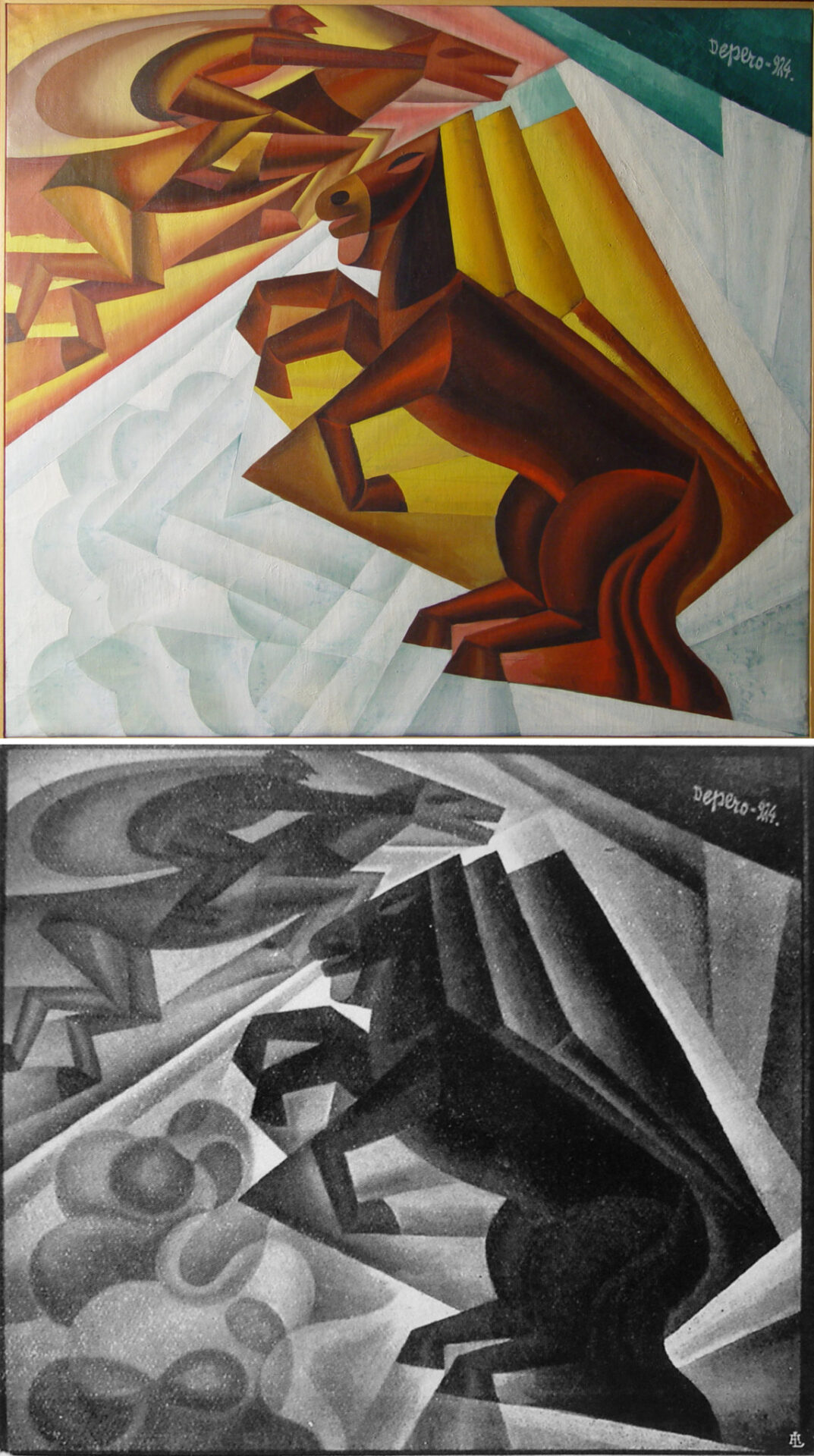
In the 1924 Gara ippica tra le nubi (Horse Race Among the Clouds; oil on canvas, 44 1/16 x 49 3/16 in.; 112 x 125 cm; Private Collection; figure 27, top), a green color is found under the white dust in front of the horse. A larger area painted in green, not unlike that in Spazialità lunari of the same year, was covered by layers of white, as well as the more curved shapes and lines of the bottom left foreground rediscovered by IR Reflectography (figure 28); these forms are the same as those visible in the image published in 1927 in the so-called ‘Bolted Book’ (published as Depero Futurista by Dinamo-Azari; figure 27, bottom). This analogy would date the changes to sometime after 1927 (if not after his New York sojourn in 1930). Reworking this piece, Depero opted for the triangles that would imbue the horse with greater dynamism, prolonging its forward movement. Furthermore, he gave a lighter appearance to the image by adding yellow (frequently over brown layers) and white (over green). In this way, his figures were rendered more isolated and stand out more clearly. Some painted zones were deliberately left incomplete, as in Spazialità lunari. The signature and date marking this picture is the original one.
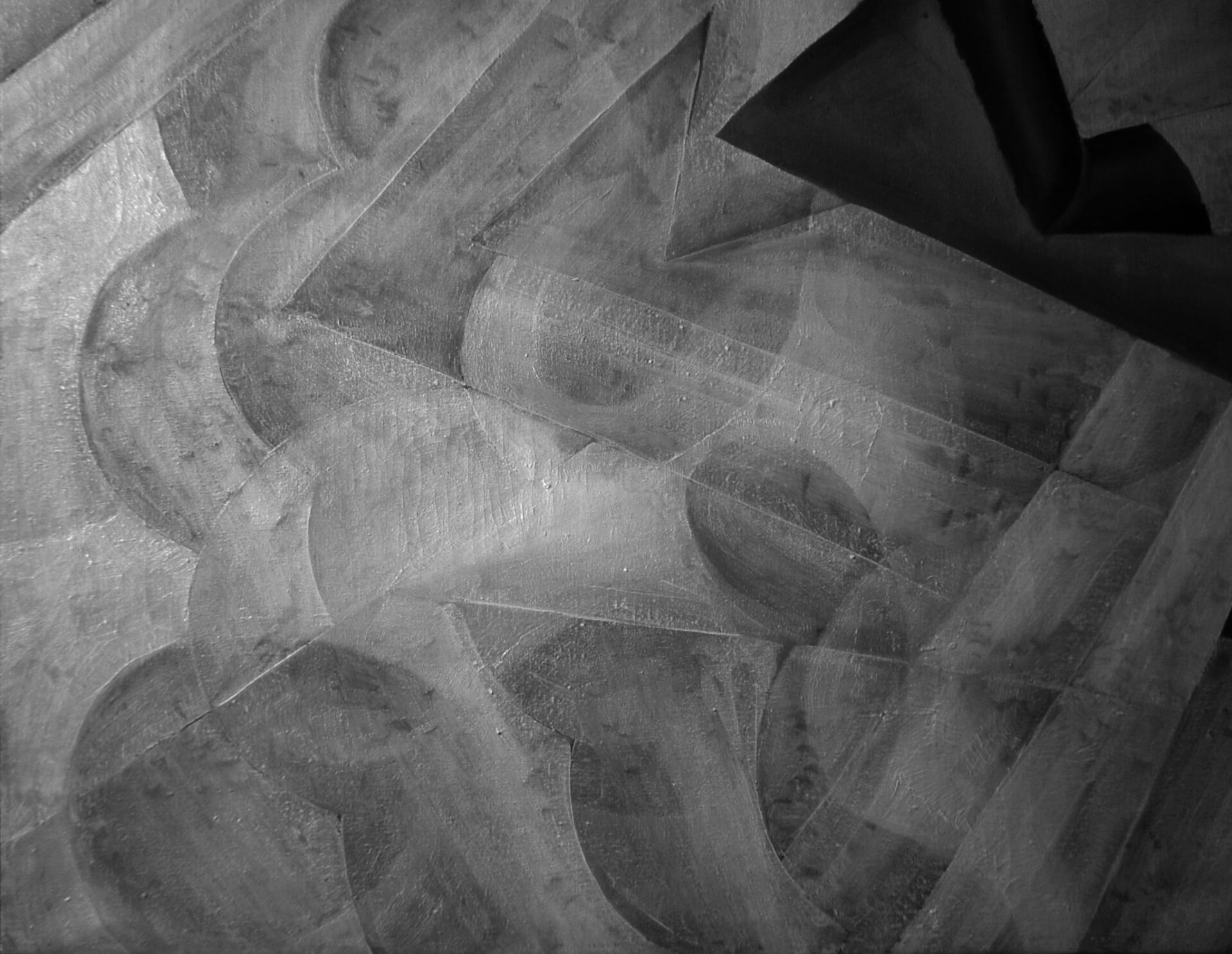
The verso of the same canvas shows it has been reused, with a large grey rectangle covering an earlier composition where green, red, orange, blue, and yellow hues were used (figure 29). We can also see a curious wooden stretcher, clearly homemade (perhaps by Depero himself). A hidden figure manifests through IR analysis (figure 30): a horseman bearing a flag, similar to the 1923 Cavaliere piumato. Altogether, this image in the verso recalls Spazialità lunari, in which a part of the same composition has been re-used as a new canvas.
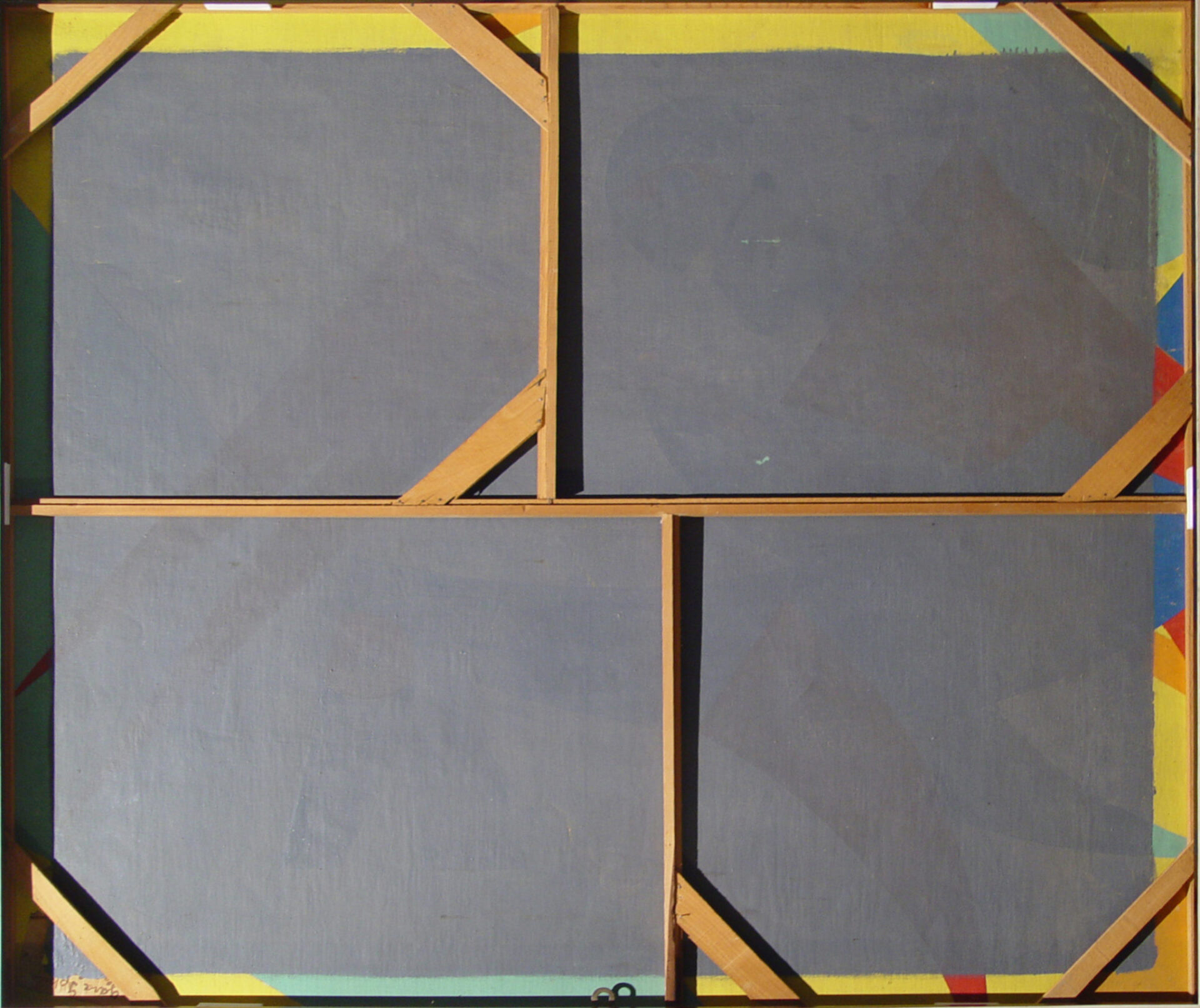
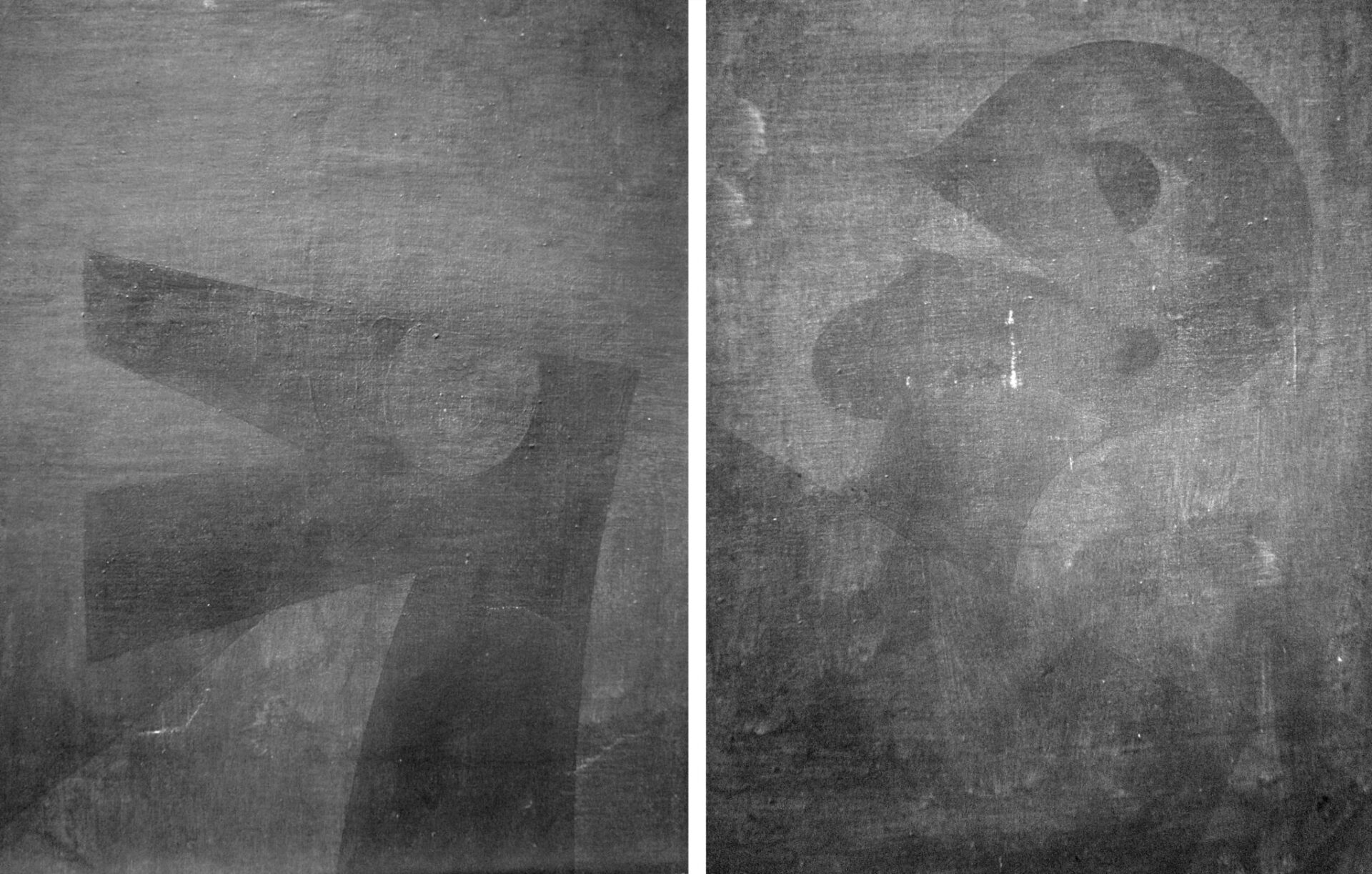
The 1927 Scarabeo veneziano (Il gondoliere) (Venetian Beetle (The Gondolier); 23 5/8 x 35 7/16 in.; 60 x 90 cm; Private Collection, Milan) presents a similar state of affairs. This painting represents yet another interpretation (figure 31) of the motif of the knight on the horse, and the verso shows the animal’s hind legs.
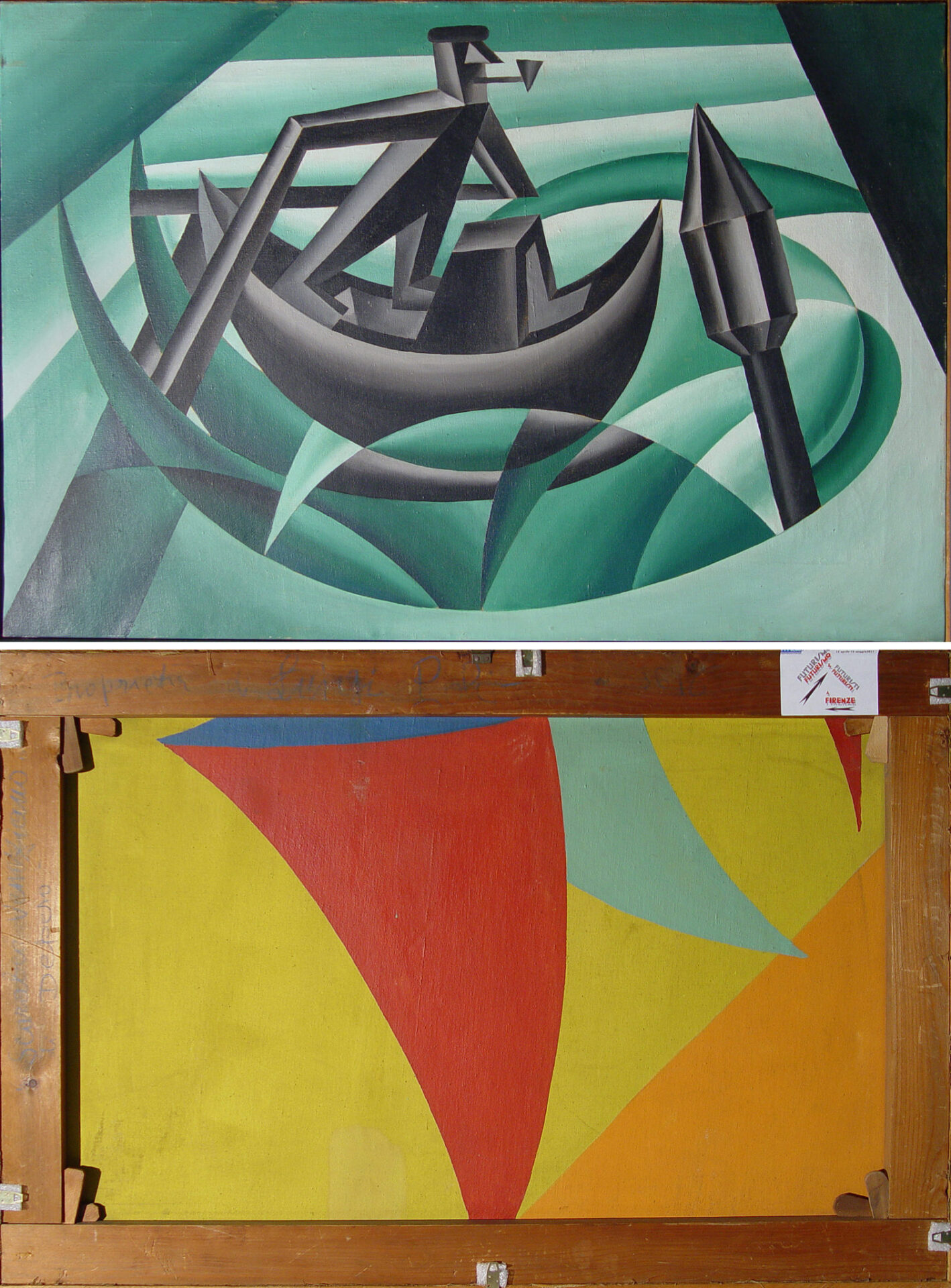
To uncover the original work connected with this canvas, one should look at the ceiling of the Salone Depero at the Prima Internazionale d’Arte Decorativa of Monza of 1923 (figure 32). In the photograph, published in the ‘Bolted Book’ (Depero Futurista, 39), a sequence of knights standing in a seemingly choreographed formation appears on a large canvas that has been applied to the ceiling, thus conferring rhythm to the space and fostering connections between sculptures and other works representing the same motif in the same room. The decoration of this ceiling was painted with flat brushstrokes like a scenography. As our findings reveal, it was later preserved, cut, and reused after the event as a support for other paintings: parts of the original composition appear on the verso of new works, including the aforementioned paintings (as well as others produced during the same period).
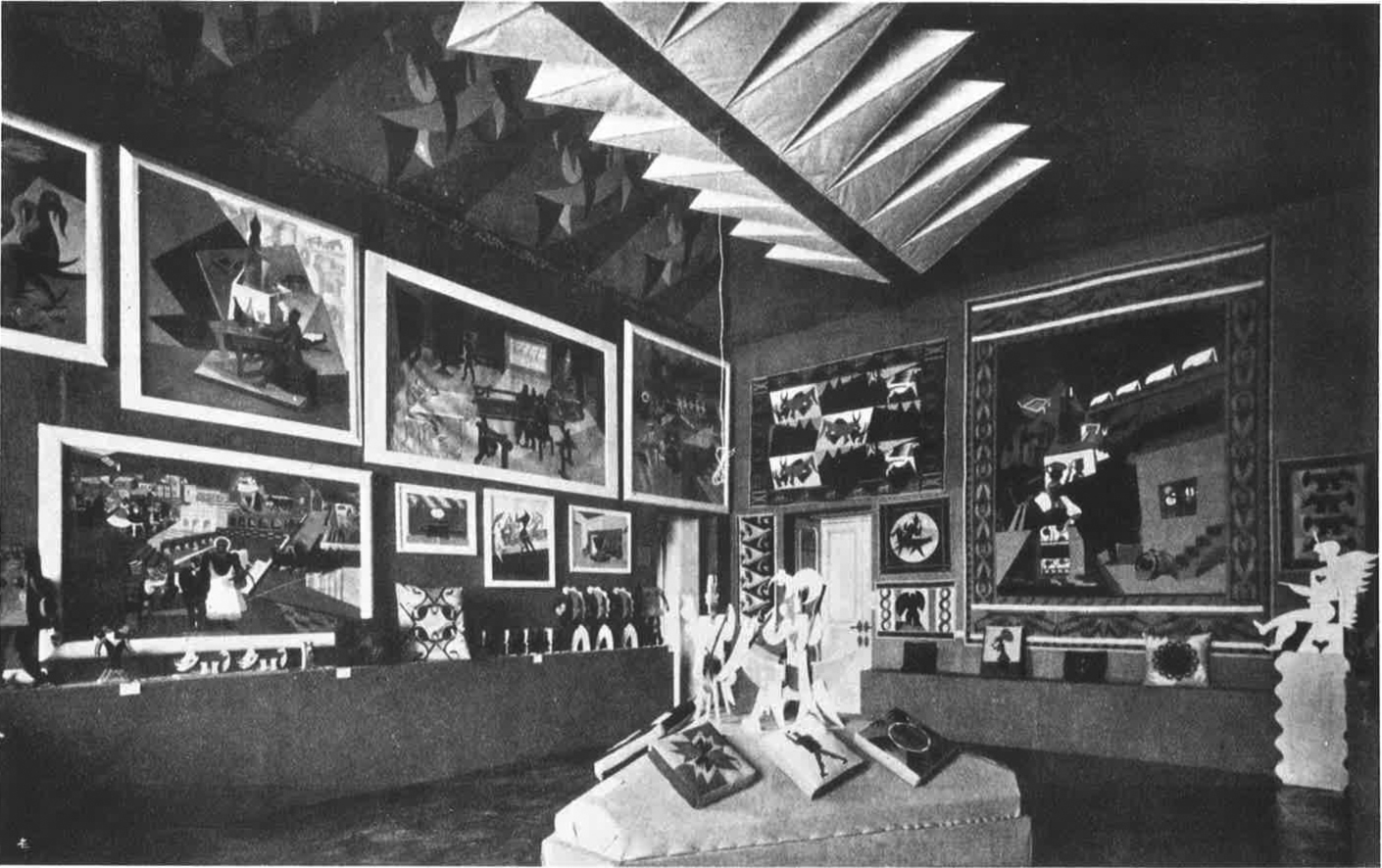
About underdrawing, one finds the same linear, precise trace under many oil paintings from the 1920s, such as the 1922 Ritratto psicologico dell’aviatore Azari (Psychological Portrait of the Pilot Azari; 55 1/8 x 36 5/8 in.; 140 x 93 cm; Private Collection, Brescia), the 1924 Marinetti temporale patriottico: Ritratto psicologico, the 1929 Big sale, or Mercato di Down-Town (Big Sale, or Downtown Market; oil on canvas, 45 11/16 x 72 7/16 in.; 116 x 184 cm; Private Collection). The 1935 Proclamazione e trionfo del tricolore (Proclamation and Triumph of the Tricolor; tempera on paper applied to masonite, 89 3/4 x 55 1/2 in.; 228 x 141 cm; MART) is also characterized by this kind of underdrawing.

In this painting (figure 33), IR reflectography revealed a large accurate sketch for a mosaic dedicated to the Italian flag (‘il tricolore’) – which was intended for the new railway station in Reggio Emilia – as well as several other changes: the dates “1915” and “1918” were revealed under the yellow wall along the arches of Trento and Trieste; horizontal lines were traced in the central place dedicated to Africa, in the background of the palm a mosque with its minaret was drawn, with a rayed sunset close to it. Another rayed star was made in the perspective box over “Reggio Emilia,” behind the blue Lombard tower, while, in the box on the right, rays were drawn and then covered with paint, and a very different building was prepared instead of the actual red-yellow one with its arcades (figures 34–35).
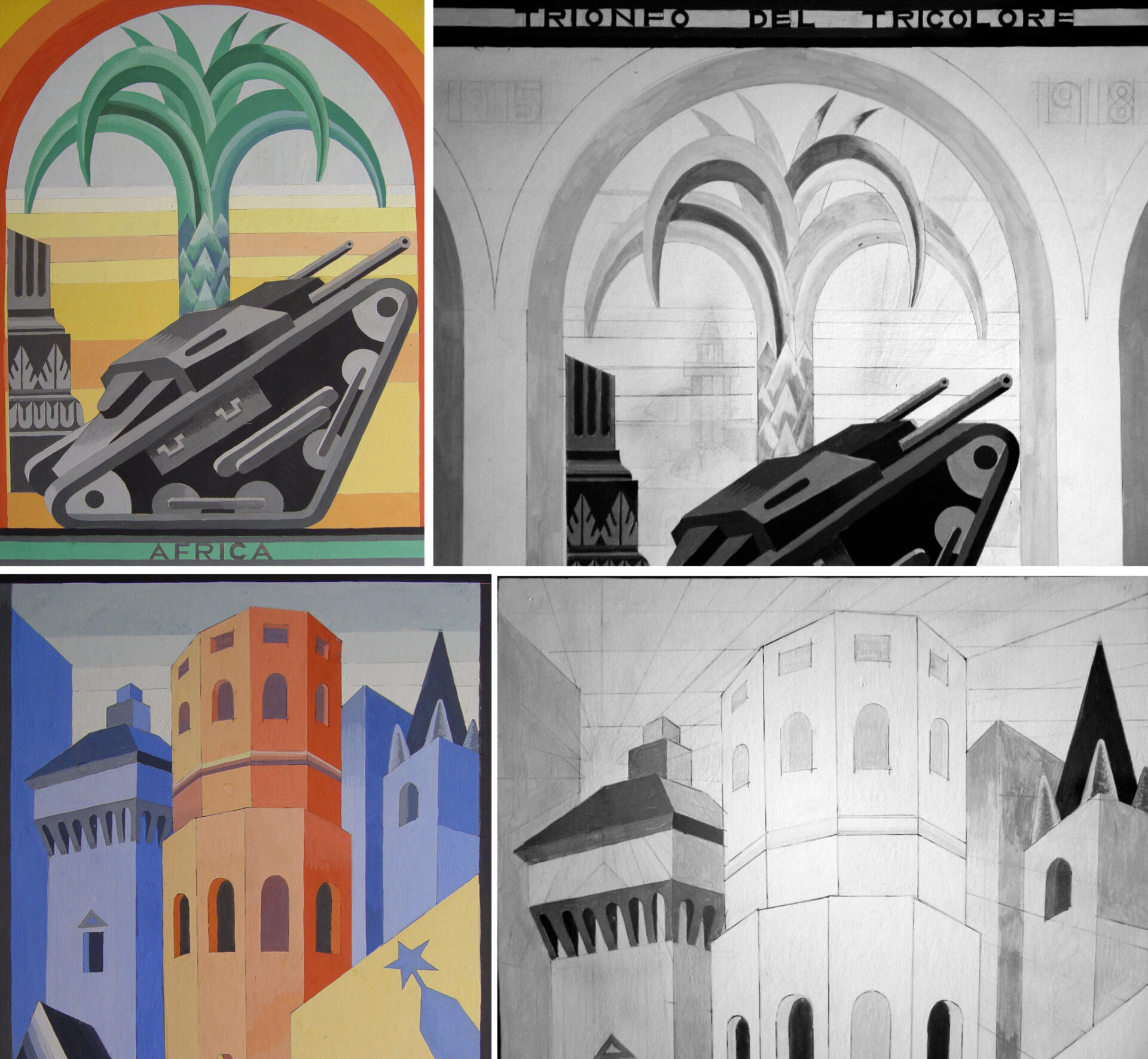
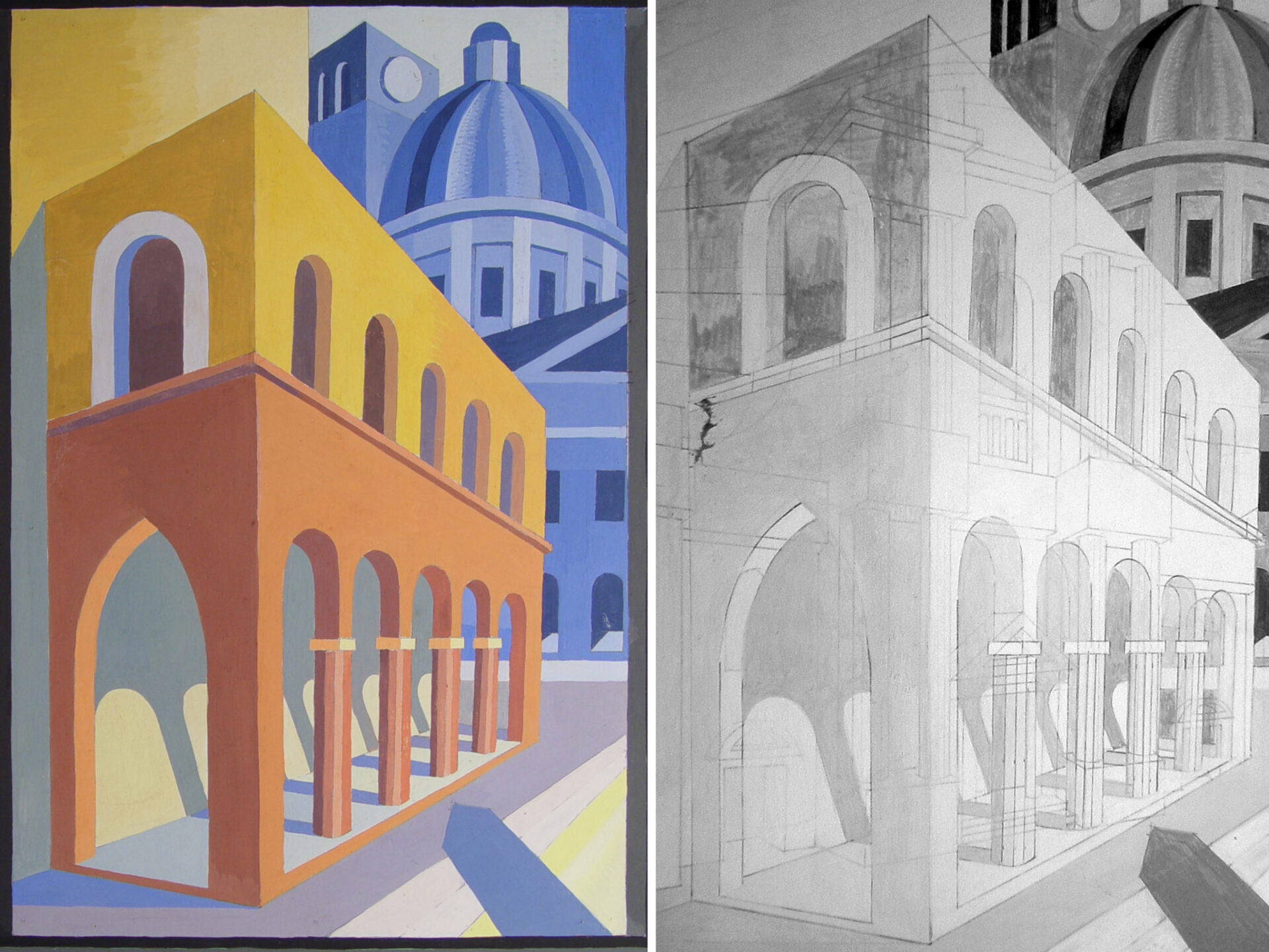
The signature of some paintings belonging to these early years raises some important issues. Except in embroideries (where his inscriptions read “Depero”), Depero typically signed his last name in capital letters until the 1920s. Around 1927, slightly before his departure to New York, “p-bar” (i. e. “p” cut by the horizontal dash along the shaft) began appearing in his inscriptions. We do not find this notation – or even “p” with an underscore – in the ‘Bolted Book,’ nor in the signature of the Panoramagico of 1925 (Depero Futurista, 115), nor in the Campari advertisements (Depero Futurista, 191–197) – which are black & white prints dated 1926–1927. The signature on the Costumi per ANIHCCAM del 3000 of 1924 (Depero Futurista, 139) has a “p-bar” that can be interpreted as a quick underscore, but that handwritten entry belongs to 1927. A “p” underlined with a short dash appears in the colored prints of Mandorlato ‘Vido’ (1924), Study for the RIM ads (1924–1926).45 The “p-bar” probably evolved from the underlined “p,” which intended to emphasize to the author’s surname. In the Unica confectionery company ads from 1927–1928 (all colored typographic prints), the printed signature clearly includes the “p-bar,”46 as do those inscriptions in the many colored prints that the artist completed in New York (October 1928–October 1930). Of course, we can find many “p-bar” signatures in works prior to 1927, presumably added later (we can be sure only for some of them), as exams can demonstrate when a previous signature is found under the repainting, as in some of the former Gianni Mattioli pieces, or as photographs of the time can prove. It is known, in fact, that Depero, as many other artists, signed a lot of his works (also on paper) years later, when he had to show, publish, or sell them. An in-depth study of these documents should be undertaken. In the case of embroideries, the signature could be considered coeval, but we know that some confusion in dating exists also about such objects.
Bibliography
Baldacci, Paolo and Gianluca Poldi. “‘La camera incantata’ e ‘Madre e figlio’: il metodo di lavoro di Carrà nel 1917 tra Villa del Seminario e la mostra alla Galleria Paolo Chini.” Studi OnLine. Archivio dell’Arte Metafisica II, 4 (2015; but 2016): 20–31.
Belli, Gabriella. La casa del mago: Le arti applicate nell’opera di Fortunato Depero 1920–1942. Milan: Charta, 1992. Exhibition catalogue.
Belli, Gabriella and Beatrice Avanzi, eds. Depero Pubblicitario: dall’auto-réclame all’architettura pubblicitaria. Milan: Skira, 2007. Exhibition catalogue.
Bosia, Daniela. Il Buxus: un materiale “moderno.” Milan: Franco Angeli, 2005.
Depero, Fortunato. Depero Futurista. Milan: Dinamo Azari, 1927.
de Finis, Lia, ed. La Scuola Reale Elisabettina di Rovereto: Docenti e allievi nel contesto del primo Novecento. Trento: Fondazione Cassa di Risparmio di Trento e Rovereto, 2008. Exhibition catalogue.
Fagiolo Dell’Arco, Maurizio, ed. Depero. Milan: Electa, 1989. Exhibition catalogue.
Galeotti, Monica, Daniela Pinna, and Rocco Mazzeo, eds. Scientific Examination for the Investigation of Paintings: A Handbook for Conservators-Restorers. Centro Di: Florence, 2009.
Oltrogge, Doris. “The Use of VIS Spectroscopy in Non-Destructive Paint Analysis,” online-edition available at http://www.museenkoeln.de/impressionismus/download/Oltrogge_VIS-Spectroscopy_eng.pdf, Cologne, 2008.
Poldi, Gianluca. “Reflectographic Analysis of Some Paintings in the Mattioli Collection.” In The Mattioli Collection: Masterpieces of the Italian Avant-Garde, edited by Flavio Fergonzi, 409–428. Milan: Skira, 2003.
Poldi, Gianluca. “Spettrometria in riflettanza e pigmenti dei Divisionisti: Uno studio sulla Pellizza da Volpedo.” In Colore ed arte: Storia e tecnologia del colore nei secoli, edited by Mauro Bacci, 69–84. Bologna: Patron, 2008.
Poldi, Gianluca. “The Painting Technique of Depero. A Scientific Study.” In Futurist Depero: 1913–1950, edited by Manuel Fontán del Junco, Llanos Gómez, and Erica Witschey, 267–279. Madrid: Fundación Juan March, 2014. Exhibition catalogue.
Poldi, Gianluca. “Carrà in infrarosso, 1916–1921. Per un esame delle fasi intermedie delle elaborazioni.” Studi OnLine. Archivio dell’Arte Metafisica IV, 7–8 (January–December 2017; but 2018): 64–78.
Poldi, Gianluca and Giovanni Carlo Federico Villa. Dalla conservazione alla storia dell’arte: Riflettografia e analisi non invasive per lo studio dei dipinti. Pisa: Edizioni della Scuola Normale Superiore, 2006.
Poldi, Gianluca and Simone Caglio. “Phthalocyanine Identification in Paintings by Reflectance Spectroscopy: A Laboratory and in situ Study.” Optics and Spectroscopy 114, 6 (2013): 929–935.
Scudiero, Maurizio. “La ricerca deperiana: problemi di metodo.” In Depero, edited by Maurizio Fagiolo Dell’Arco, 226–236. Milan, Electa: 1989. Exhibition catalogue.
How to cite
Gianluca Poldi, “Depero’s Painting Technique and Variations. A Scientific Approach,” in Fortunato Depero, monographic issue of Italian Modern Art, 1 (January 2019), https://www.italianmodernart.org/journal/articles/deperos-painting-technique-and-variations-a-scientific-approach/, accessed [insert date].
- The research described was made possible by the generosity of Laura Mattioli and Manuel Fontán del Junco, director of the Fundación Juan March, Madrid. This text is the expanded version of the essay, Gianluca Poldi, “The Painting Technique of Depero. A Scientific Study,” in Futurist Depero: 1913–1950, eds. Manuel Fontán del Junco, Llanos Gómez, and Erica Witschey, exh. cat. (Madrid: Fundación Juan March, 2014), 267–279. The republication is possible by courtesy of the Fundación Juan March. In particular, the observations on Paese di tarantelle are increased. The last paragraph (“New findings: among changes, reuses and signatures”) is completely new and concerns works I studied during the Madrid exhibition, and later presented at a conference held at that Foundation in Madrid on October 13, 2014. The preliminary findings of the study were presented at the Fortunato Depero Study Day held at the Center for Italian Modern Art (CIMA) in New York on February 21, 2014. For the possibility of carrying out this diagnostic research I am grateful, in addition to Laura Mattioli and Manuel Fontán del Junco, to Philip Rylands, Siginro De Boni, Heather Ewing, Fabio Belloni, Milena Dean, Nicholas Fox Weber, Eugenia De Beni, and Luciano Pasabene Buemi. I own the copyright on technical images.
- The analyses carried out partly align with the research activity of the Centro d’Ateneo di Arte Visive (CAV) at the University of Bergamo. The author’s archive includes thousands of paintings from different periods, including many Futurist works, that have been investigated over eighteen years.
- The infrared reflectography (IRR) and transmitted infrared analyses (TIR) – both useful to identify the presence of underdrawings, graphic or pictorial changes, and reuses of the support – were carried out mainly with a Sony digital camera (5 mpx, maximum resolution of about 20 dots/mm, CCD silicon detector, operating in the range 0.85–1 micron) and illumination with 1000W halogen light. In some cases, use was also made of an Osiris (Optical, Spectroscopic, and Infrared Remote Imaging System) remote IR scansion system made by Opus Instruments (InGaAs detector, spectral range 1–1.7 micron). The camera was also employed for the shots in visible light and FCIR – the latter to study the surface distribution of certain pigments and the presence of retouches/repainting. For the images in visible light and UV fluorescence (with a light with a maximum emission of 365 nm) use was also made of a 16 mpx Nikon camera. On the non-invasive techniques mentioned in the text see, for example, Daniela Pinna, Monica Galeotti, and Rocco Mazzeo, eds., Scientific Examination for the Investigation of Paintings: A Handbook for Conservators-Restorers (Florence: Centro Di 2009); and Gianluca Poldi and Giovanni Carlo Federico Villa, Dalla conservazione alla storia dell’arte: Riflettografia e analisi non invasive per lo studio dei dipinti (Pisa: Edizioni della Scuola Normale Superiore, 2006).
- For the visible reflectance spectroscopy analysis (vis-RS) – useful to recognize even organic pigments on the superficial chromatic layer – use was made of a Minolta CM 2600d spectrophotometer fitted with an inner integrating sphere, operating in the range of 360–740 nm with an acquisition rate of 10 nm, and a measurement area with a diameter of 3 mm. The evaluation of the vis-RS spectra was carried out on the basis of a broad personal reference database. On the potential of this technique for modern pigments, see Gianluca Poldi, “Spettrometria in riflettanza e pigmenti dei Divisionisti: Uno studio sulla Pellizza da Volpedo,” in Colore ed arte: Storia e tecnologia del colore nei secoli, ed. Mauro Bacci (Bologna: Patron, 2008), 69–84; Doris Oltrogge, “The Use of VIS Spectroscopy in Non-Destructive Paint Analysis,” online-edition available at http://www.museenkoeln.de/impressionismus/download/Oltrogge_VIS-Spectroscopy_eng.pdf, Cologne, 2008.
- In the unlined paintings examined, in many cases, the original stretcher is conserved.
- The signature does not present the “p” cut by the horizontal dash along the shaft, which appeared around the second half of the 1920s.
- See Lia de Finis, ed., La Scuola Reale Elisabettina di Rovereto: docenti e allievi nel contesto del primo Novecento (Trento: Fondazione Cassa di Risparmio di Trento e Rovereto, 2008), in particular 96, 166–167. I believe that much of Depero’s skill derived from the teaching of geometric constructions by Cesare Coriselli (1878–1943), who, among other things, made students work on the interconnection of solid figures. Finis, La Scuola Reale Elisabettina di Rovereto, 71–87.
- The painting that shows most signs of restoration, with various retouches clearly visible in UV light, is the Ritratto di Gilbert Clavel, examined at the Peggy Guggenheim Collection in Venice.
- The term Tüchlein designates a kind of painting and technique that was widespread in the fifteenth and sixteenth centuries in Flanders and in German-speaking countries, and in a more limited way in Italy, which imitated the textile surface of tapestries and embroideries, but also certain aspects of wall painting. Frequently decorative, but often also containing religious subjects, the Tüchlein were made with thin tempera on unprimed linen canvas, and the natural color of the canvas in the background can be partially visible. Given the highly perishable nature of these objects, the material evidence of this tradition is rare.
- These lumps and areas of yellowing appear in the original background areas, but not in those restored by the artist at a later date, so that a criterion for identifying the areas not retouched by the artist is often (though not always) the presence of these alterations. This is not the case with the Diavoletti di caucciù a scatto (Little Rubber Devils), where there are no revisions, but which is nevertheless in a good state of conservation.
- It is not clear whether the varnishing was done after the reduction of the canvas. In any event, the presence of brush hairs in some colors is clearly visible.
- For the identification of certain typologies of greens, orange-yellows, and reds, reflectance spectroscopy (RS) is not usually sufficient and must be accompanied by other non-invasive spectroscopic analyses, such as those involving X-ray fluorescence (XRF), capable of identifying the chemical elements forming many organic pigments. However, even where the compound cannot be distinguished, the vis-RS makes it possible to obtain molecular spectrums of the surface pigments that offer basic data for the comparison of authentic and forged works. It is worth noting that the vis-RS spectrums collected, grouped by color class, can be classified in precise typologies on the basis of their common features, pointing to the fact that the artist’s palette and his preferred choices remained for the most part constant throughout the course of the decade examined. This also applies to the watercolors.
- Among the watercolors examined are the Chimera of 1916, the Ritratto di Gilbert Clavel, and Automi. Prospettiva dinamica figurata (Automata. Dynamic Perspective with Figures), which were both produced in 1917.
- I am indebted to my colleague Maria Letizia Amadori (University of Urbino) for the cross section of this sample studied by optical and electronic microscopy (SEM+EDS), and for the FTIR exams on the lump sample cited above.
- In fact, the absorption bands typical of crimson lakes at 520–530 and 570 nm are evident in vis-RS.
- Unlike other paintings in the Mattioli Collection held at the Fondazione Peggy Guggenheim in Venice, I did not examine this painting for the catalogue raisonné. Gianluca Poldi, “Reflectographic Analysis of Some Paintings in the Mattioli Collection,” in The Mattioli Collection: Masterpieces of the Italian Avant-Garde, ed. Flavio Fergonzi (Milan: Skira, 2003), 409–428.
- In this painting there is also a chromatic modification: Depero uses a lighter green to correct certain parts of the chair that were originally painted in a darker green, while some light-colored halos on the edge of the dark green background (in the faces) seem intentional, and are difficult to find in later works. There is evidence of similar chromatic variations in the greens, which would seem to be partly due to alterations, in a version of the Manifesto per Balli plastici (Manifesto for Plastic Dances), described as “tempera on canvas, 99 x 69 cm (40 x 27 1/5 in.), private collection” and dated 1917–1918 in Maurizio Fagiolo Dell’Arco, ed., Depero, exh. cat. (Milan: Electa, 1989), 111.
- The photograph, which Depero titled Angolo della mia officina (Corner of my Workshop), for example, is published in Fagiolo Dell’Arco, Depero, 120.
- The drawing (published in Fagiolo Dell’Arco, Depero, 77) is thus definitely preparatory.
- According to Maurizio Scudiero, “La ricerca deperiana: problemi di metodo,” in Depero, ed. Maurizio Fagiolo Dell’Arco, exh. cat. (Milan, Electa: 1989), 226–236, the painting “was, in the early 1920s, already cleaned and made lighter, above all in the dancing group in the foreground” (229).
- A detail was published in Fagiolo Dell’Arco, Depero, 98, but a serious comparison between the versions was never addressed.
- The same decorative motif appears in the drawing on the back of the canvas of Rotazione di ballerina e pappagalli (Rotation of Dancer and Parrots) but not in its modified version painted in 1918 in Clavel nella funicolare (Clavel in the Funicular), in a private collection.
- Also at MART. Archivio del ’900, Fondo Depero, 7.1.3.4.6.
- Essentially, the right part was partially painted.
- A part of the original subject can be made out with the naked eye in the area beneath the cart, on the right, as a result of the increased transparency of the paint and the lack of chromatic uniformity in the substratum.
- Fagiolo Dell’Arco, Depero, 100–101.
- The figure on p. 92 is more than a sketch. It might be an actual underdrawing for a painting not completed with color (Fagiolo Dell’Arco, Depero, 92, 100–101).
- The indications of which colors should be used should not surprise us, and in many cases can be functional in the studio praxis of his Rovereto “Magician’s House.” Similar notes on colors are also to be found in several fifteenth- and sixteenth-century paintings, where they can be interpreted as indications intended for collaborators in the studio.
- The drawings, rightly regarded as preparatory (as shown by the findings of the present analyses), are published in Gabriella Belli, ed., La casa del mago: Le arti applicate nell’opera di Fortunato Depero 1920–1942, exh. cat. (Milan: Charta, 1992), 90.
- Fagiolo Dell’Arco, Depero, 138–139.
- As specified by Giovanna Ginex at the Fortunato Depero Study Day held at CIMA in New York on February 21, 2014 (now published here). Ginex found that Depero tried to collaborate with Bianchi, pitching a new advertising campaign to them, but in a letter of July 1928, Edoardo Bianchi rejected Depero’s proposal, saying he was not interested in the US market. See also Gianluca Poldi, From advertising to painting: Depero’s Motociclista and the Bianchi company on CIMA website (consulted on November 7, 2018). The 1925 dating in the photographic plate of the painting conserved in the Archives of MART could be a mistake. We know that Depero occasionally confused dates, sometimes due to forgetfulness, other times with the intention of backdating (about backdating see Scudiero, “La ricerca deperiana: problemi di metodo”). But we can’t rule out the possibility that the painting was realized in 1925 for a previous contact with Bianchi company (a collage of colored paper Cicli Bianchi is known, generally dated 1924–1925), so we can assume that the Motociclista was painted between 1925–1928.
- On this subject, see Scudiero, “La ricerca deperiana: problemi di metodo”, which lists among the works restored by Depero “for damage” the Selvaggi (Savages), Io e mia moglie, Flora e fauna magica, and La grande selvaggia (Great Female Savage).
- Belli, La casa del mago, 92.
- Belli, La casa del mago, 92. Selvaggetti (Small Savages) denotes I selvaggi rossi e neri (Red and Black Savages) which we address below.
- On the other hand, the compiler of the entry for La casa del mago (The Magician’s House) reckoned that the restoration work undertaken was “exclusively for conservation reasons” (see Belli, La casa del mago, 92).
- In one of the rare areas where the retouching is visible to the naked eye, along the section of the walls of the upper room, the new red appears less bright and is easily recognizable with regard to the original.
- Fagiolo Dell’Arco, Depero, 102–103.
- Fagiolo Dell’Arco, Depero, 125.
- The original coloring survives in the light blue mark in this area, in the upper right area, as well as in the arc formed by the bird’s tail; in Depero’s day it was probably not evident but it is today, probably owing to the chromatic change that has taken place over the decades.
- The painting in Rovereto shows similar characteristics to those analyzed for this study: no priming, with the canvas at the edges and sides of various background areas appearing to be beige-brown in color.
- Phthalocyanine is a bright blue or green pigment nowadays used in enamels, paints, printing inks, and plastics. For bibliography on phthalocyanines, see Gianluca Poldi and Simone Caglio, “Phthalocyanine Identification in Paintings by Reflectance Spectroscopy: A Laboratory and in situ Study,” in Optics and Spectroscopy 114, 6 (2013): 929–935.
- It should be noted that the appearance of the color in the Testa and the Cavaliere piumato is different. The background areas in the former are brighter; in the latter, on the other hand, the blue (an ultramarine), the green (with a base of phthalocyanine of the same type as that of the Testa), and the red (a ferrous oxide) are bright but opaque, and given over a white layer that covers the original coloring, a sign of interventions carried out at different times.
- Oddly enough, there is still no sufficiently systematic study of the other Futurist artists, from Boccioni to Carrà, and from Balla to Severini. On Carrà the first recognitions are: Paolo Baldacci and Gianluca Poldi, “‘La camera incantata’ e ‘Madre e figlio’: Il metodo di lavoro di Carrà nel 1917 tra Villa del Seminario e la mostra alla Galleria Paolo Chini,” Studi OnLine. Archivio dell’Arte Metafisica II, 4 (July–December 2015; but 2016): 20–31; Gianluca Poldi, “Carrà in infrarosso, 1916–1921: Per un esame delle fasi intermedie delle elaborazioni,” Studi OnLine. Archivio dell’Arte Metafisica IV, 7–8 (January–December 2017; but 2018): 64–78.
- Buxus was a cladding material used for architectural, industrial, and decorative purposes, devised and produced in Italy by the Giacomo Bosso paper mills from 1928, during the autarky promoted by the Fascist government. It is a tough, elastic material, with marble-like veins, obtained by a process involving the treatment of cellulose. In the 1930s it was one of the most widespread substitutes for wood. On the history of buxus and its use by Depero, see Daniela Bosia, Il Buxus: Un materiale “moderno” (Milan: Franco Angeli, 2005).
- Gabriella Belli and Beatrice Avanzi, eds., Depero Pubblicitario: Dall’auto-réclame all’architettura pubblicitaria, exh. cat. (Milan: Skira, 2008), 237, 243.
- Belli and Avanzi, Depero pubblicitario, cat. 77 and 78; 138–139.

